
11 Surprising Homework Statistics, Facts & Data

The age-old question of whether homework is good or bad for students is unanswerable because there are so many “ it depends ” factors.
For example, it depends on the age of the child, the type of homework being assigned, and even the child’s needs.
There are also many conflicting reports on whether homework is good or bad. This is a topic that largely relies on data interpretation for the researcher to come to their conclusions.
To cut through some of the fog, below I’ve outlined some great homework statistics that can help us understand the effects of homework on children.
Homework Statistics List
1. 45% of parents think homework is too easy for their children.
A study by the Center for American Progress found that parents are almost twice as likely to believe their children’s homework is too easy than to disagree with that statement.
Here are the figures for math homework:
- 46% of parents think their child’s math homework is too easy.
- 25% of parents think their child’s math homework is not too easy.
- 29% of parents offered no opinion.
Here are the figures for language arts homework:
- 44% of parents think their child’s language arts homework is too easy.
- 28% of parents think their child’s language arts homework is not too easy.
- 28% of parents offered no opinion.
These findings are based on online surveys of 372 parents of school-aged children conducted in 2018.
2. 93% of Fourth Grade Children Worldwide are Assigned Homework
The prestigious worldwide math assessment Trends in International Maths and Science Study (TIMSS) took a survey of worldwide homework trends in 2007. Their study concluded that 93% of fourth-grade children are regularly assigned homework, while just 7% never or rarely have homework assigned.
3. 17% of Teens Regularly Miss Homework due to Lack of High-Speed Internet Access
A 2018 Pew Research poll of 743 US teens found that 17%, or almost 2 in every 5 students, regularly struggled to complete homework because they didn’t have reliable access to the internet.
This figure rose to 25% of Black American teens and 24% of teens whose families have an income of less than $30,000 per year.
4. Parents Spend 6.7 Hours Per Week on their Children’s Homework
A 2018 study of 27,500 parents around the world found that the average amount of time parents spend on homework with their child is 6.7 hours per week. Furthermore, 25% of parents spend more than 7 hours per week on their child’s homework.
American parents spend slightly below average at 6.2 hours per week, while Indian parents spend 12 hours per week and Japanese parents spend 2.6 hours per week.
5. Students in High-Performing High Schools Spend on Average 3.1 Hours per night Doing Homework
A study by Galloway, Conner & Pope (2013) conducted a sample of 4,317 students from 10 high-performing high schools in upper-middle-class California.
Across these high-performing schools, students self-reported that they did 3.1 hours per night of homework.
Graduates from those schools also ended up going on to college 93% of the time.
6. One to Two Hours is the Optimal Duration for Homework
A 2012 peer-reviewed study in the High School Journal found that students who conducted between one and two hours achieved higher results in tests than any other group.
However, the authors were quick to highlight that this “t is an oversimplification of a much more complex problem.” I’m inclined to agree. The greater variable is likely the quality of the homework than time spent on it.
Nevertheless, one result was unequivocal: that some homework is better than none at all : “students who complete any amount of homework earn higher test scores than their peers who do not complete homework.”
7. 74% of Teens cite Homework as a Source of Stress
A study by the Better Sleep Council found that homework is a source of stress for 74% of students. Only school grades, at 75%, rated higher in the study.
That figure rises for girls, with 80% of girls citing homework as a source of stress.
Similarly, the study by Galloway, Conner & Pope (2013) found that 56% of students cite homework as a “primary stressor” in their lives.
8. US Teens Spend more than 15 Hours per Week on Homework
The same study by the Better Sleep Council also found that US teens spend over 2 hours per school night on homework, and overall this added up to over 15 hours per week.
Surprisingly, 4% of US teens say they do more than 6 hours of homework per night. That’s almost as much homework as there are hours in the school day.
The only activity that teens self-reported as doing more than homework was engaging in electronics, which included using phones, playing video games, and watching TV.
9. The 10-Minute Rule
The National Education Association (USA) endorses the concept of doing 10 minutes of homework per night per grade.
For example, if you are in 3rd grade, you should do 30 minutes of homework per night. If you are in 4th grade, you should do 40 minutes of homework per night.
However, this ‘rule’ appears not to be based in sound research. Nevertheless, it is true that homework benefits (no matter the quality of the homework) will likely wane after 2 hours (120 minutes) per night, which would be the NEA guidelines’ peak in grade 12.
10. 21.9% of Parents are Too Busy for their Children’s Homework
An online poll of nearly 300 parents found that 21.9% are too busy to review their children’s homework. On top of this, 31.6% of parents do not look at their children’s homework because their children do not want their help. For these parents, their children’s unwillingness to accept their support is a key source of frustration.
11. 46.5% of Parents find Homework too Hard
The same online poll of parents of children from grades 1 to 12 also found that many parents struggle to help their children with homework because parents find it confusing themselves. Unfortunately, the study did not ask the age of the students so more data is required here to get a full picture of the issue.
Get a Pdf of this article for class
Enjoy subscriber-only access to this article’s pdf
Interpreting the Data
Unfortunately, homework is one of those topics that can be interpreted by different people pursuing differing agendas. All studies of homework have a wide range of variables, such as:
- What age were the children in the study?
- What was the homework they were assigned?
- What tools were available to them?
- What were the cultural attitudes to homework and how did they impact the study?
- Is the study replicable?
The more questions we ask about the data, the more we realize that it’s hard to come to firm conclusions about the pros and cons of homework .
Furthermore, questions about the opportunity cost of homework remain. Even if homework is good for children’s test scores, is it worthwhile if the children consequently do less exercise or experience more stress?
Thus, this ends up becoming a largely qualitative exercise. If parents and teachers zoom in on an individual child’s needs, they’ll be able to more effectively understand how much homework a child needs as well as the type of homework they should be assigned.
Related: Funny Homework Excuses
The debate over whether homework should be banned will not be resolved with these homework statistics. But, these facts and figures can help you to pursue a position in a school debate on the topic – and with that, I hope your debate goes well and you develop some great debating skills!

Chris Drew (PhD)
Dr. Chris Drew is the founder of the Helpful Professor. He holds a PhD in education and has published over 20 articles in scholarly journals. He is the former editor of the Journal of Learning Development in Higher Education. [Image Descriptor: Photo of Chris]
- Chris Drew (PhD) https://helpfulprofessor.com/author/chris-drew-phd/ 5 Top Tips for Succeeding at University
- Chris Drew (PhD) https://helpfulprofessor.com/author/chris-drew-phd/ 50 Durable Goods Examples
- Chris Drew (PhD) https://helpfulprofessor.com/author/chris-drew-phd/ 100 Consumer Goods Examples
- Chris Drew (PhD) https://helpfulprofessor.com/author/chris-drew-phd/ 30 Globalization Pros and Cons
Leave a Comment Cancel Reply
Your email address will not be published. Required fields are marked *
- Future Students
- Current Students
- Faculty/Staff

News and Media
- News & Media Home
- Research Stories
- School's In
- In the Media
You are here
More than two hours of homework may be counterproductive, research suggests.

A Stanford education researcher found that too much homework can negatively affect kids, especially their lives away from school, where family, friends and activities matter. "Our findings on the effects of homework challenge the traditional assumption that homework is inherently good," wrote Denise Pope , a senior lecturer at the Stanford Graduate School of Education and a co-author of a study published in the Journal of Experimental Education . The researchers used survey data to examine perceptions about homework, student well-being and behavioral engagement in a sample of 4,317 students from 10 high-performing high schools in upper-middle-class California communities. Along with the survey data, Pope and her colleagues used open-ended answers to explore the students' views on homework. Median household income exceeded $90,000 in these communities, and 93 percent of the students went on to college, either two-year or four-year. Students in these schools average about 3.1 hours of homework each night. "The findings address how current homework practices in privileged, high-performing schools sustain students' advantage in competitive climates yet hinder learning, full engagement and well-being," Pope wrote. Pope and her colleagues found that too much homework can diminish its effectiveness and even be counterproductive. They cite prior research indicating that homework benefits plateau at about two hours per night, and that 90 minutes to two and a half hours is optimal for high school. Their study found that too much homework is associated with: • Greater stress : 56 percent of the students considered homework a primary source of stress, according to the survey data. Forty-three percent viewed tests as a primary stressor, while 33 percent put the pressure to get good grades in that category. Less than 1 percent of the students said homework was not a stressor. • Reductions in health : In their open-ended answers, many students said their homework load led to sleep deprivation and other health problems. The researchers asked students whether they experienced health issues such as headaches, exhaustion, sleep deprivation, weight loss and stomach problems. • Less time for friends, family and extracurricular pursuits : Both the survey data and student responses indicate that spending too much time on homework meant that students were "not meeting their developmental needs or cultivating other critical life skills," according to the researchers. Students were more likely to drop activities, not see friends or family, and not pursue hobbies they enjoy. A balancing act The results offer empirical evidence that many students struggle to find balance between homework, extracurricular activities and social time, the researchers said. Many students felt forced or obligated to choose homework over developing other talents or skills. Also, there was no relationship between the time spent on homework and how much the student enjoyed it. The research quoted students as saying they often do homework they see as "pointless" or "mindless" in order to keep their grades up. "This kind of busy work, by its very nature, discourages learning and instead promotes doing homework simply to get points," said Pope, who is also a co-founder of Challenge Success , a nonprofit organization affiliated with the GSE that conducts research and works with schools and parents to improve students' educational experiences.. Pope said the research calls into question the value of assigning large amounts of homework in high-performing schools. Homework should not be simply assigned as a routine practice, she said. "Rather, any homework assigned should have a purpose and benefit, and it should be designed to cultivate learning and development," wrote Pope. High-performing paradox In places where students attend high-performing schools, too much homework can reduce their time to foster skills in the area of personal responsibility, the researchers concluded. "Young people are spending more time alone," they wrote, "which means less time for family and fewer opportunities to engage in their communities." Student perspectives The researchers say that while their open-ended or "self-reporting" methodology to gauge student concerns about homework may have limitations – some might regard it as an opportunity for "typical adolescent complaining" – it was important to learn firsthand what the students believe. The paper was co-authored by Mollie Galloway from Lewis and Clark College and Jerusha Conner from Villanova University.
Clifton B. Parker is a writer at the Stanford News Service .
More Stories

⟵ Go to all Research Stories
Get the Educator
Subscribe to our monthly newsletter.
Stanford Graduate School of Education
482 Galvez Mall Stanford, CA 94305-3096 Tel: (650) 723-2109
- Contact Admissions
- GSE Leadership
- Site Feedback
- Web Accessibility
- Career Resources
- Faculty Open Positions
- Explore Courses
- Academic Calendar
- Office of the Registrar
- Cubberley Library
- StanfordWho
- StanfordYou
Improving lives through learning

- Stanford Home
- Maps & Directions
- Search Stanford
- Emergency Info
- Terms of Use
- Non-Discrimination
- Accessibility
© Stanford University , Stanford , California 94305 .
share this!
August 16, 2021
Is it time to get rid of homework? Mental health experts weigh in
by Sara M Moniuszko

It's no secret that kids hate homework. And as students grapple with an ongoing pandemic that has had a wide-range of mental health impacts, is it time schools start listening to their pleas over workloads?
Some teachers are turning to social media to take a stand against homework .
Tiktok user @misguided.teacher says he doesn't assign it because the "whole premise of homework is flawed."
For starters, he says he can't grade work on "even playing fields" when students' home environments can be vastly different.
"Even students who go home to a peaceful house, do they really want to spend their time on busy work? Because typically that's what a lot of homework is, it's busy work," he says in the video that has garnered 1.6 million likes. "You only get one year to be 7, you only got one year to be 10, you only get one year to be 16, 18."
Mental health experts agree heavy work loads have the potential do more harm than good for students, especially when taking into account the impacts of the pandemic. But they also say the answer may not be to eliminate homework altogether.
Emmy Kang, mental health counselor at Humantold, says studies have shown heavy workloads can be "detrimental" for students and cause a "big impact on their mental, physical and emotional health."
"More than half of students say that homework is their primary source of stress, and we know what stress can do on our bodies," she says, adding that staying up late to finish assignments also leads to disrupted sleep and exhaustion.
Cynthia Catchings, a licensed clinical social worker and therapist at Talkspace, says heavy workloads can also cause serious mental health problems in the long run, like anxiety and depression.
And for all the distress homework causes, it's not as useful as many may think, says Dr. Nicholas Kardaras, a psychologist and CEO of Omega Recovery treatment center.
"The research shows that there's really limited benefit of homework for elementary age students, that really the school work should be contained in the classroom," he says.
For older students, Kang says homework benefits plateau at about two hours per night.
"Most students, especially at these high-achieving schools, they're doing a minimum of three hours, and it's taking away time from their friends from their families, their extracurricular activities. And these are all very important things for a person's mental and emotional health."
Catchings, who also taught third to 12th graders for 12 years, says she's seen the positive effects of a no homework policy while working with students abroad.
"Not having homework was something that I always admired from the French students (and) the French schools, because that was helping the students to really have the time off and really disconnect from school ," she says.
The answer may not be to eliminate homework completely, but to be more mindful of the type of work students go home with, suggests Kang, who was a high-school teacher for 10 years.
"I don't think (we) should scrap homework, I think we should scrap meaningless, purposeless busy work-type homework. That's something that needs to be scrapped entirely," she says, encouraging teachers to be thoughtful and consider the amount of time it would take for students to complete assignments.
The pandemic made the conversation around homework more crucial
Mindfulness surrounding homework is especially important in the context of the last two years. Many students will be struggling with mental health issues that were brought on or worsened by the pandemic, making heavy workloads even harder to balance.
"COVID was just a disaster in terms of the lack of structure. Everything just deteriorated," Kardaras says, pointing to an increase in cognitive issues and decrease in attention spans among students. "School acts as an anchor for a lot of children, as a stabilizing force, and that disappeared."
But even if students transition back to the structure of in-person classes, Kardaras suspects students may still struggle after two school years of shifted schedules and disrupted sleeping habits.
"We've seen adults struggling to go back to in-person work environments from remote work environments. That effect is amplified with children because children have less resources to be able to cope with those transitions than adults do," he explains.
'Get organized' ahead of back-to-school
In order to make the transition back to in-person school easier, Kang encourages students to "get good sleep, exercise regularly (and) eat a healthy diet."
To help manage workloads, she suggests students "get organized."
"There's so much mental clutter up there when you're disorganized... sitting down and planning out their study schedules can really help manage their time," she says.
Breaking assignments up can also make things easier to tackle.
"I know that heavy workloads can be stressful, but if you sit down and you break down that studying into smaller chunks, they're much more manageable."
If workloads are still too much, Kang encourages students to advocate for themselves.
"They should tell their teachers when a homework assignment just took too much time or if it was too difficult for them to do on their own," she says. "It's good to speak up and ask those questions. Respectfully, of course, because these are your teachers. But still, I think sometimes teachers themselves need this feedback from their students."
©2021 USA Today Distributed by Tribune Content Agency, LLC.
Explore further
Feedback to editors

Optical barcodes expand range of high-resolution sensor
8 hours ago

Ridesourcing platforms thrive on socio-economic inequality, say researchers
9 hours ago

Did Vesuvius bury the home of the first Roman emperor?

Florida dolphin found with highly pathogenic avian flu: Report

A new way to study and help prevent landslides

New algorithm cuts through 'noisy' data to better predict tipping points

Researchers reconstruct landscapes that greeted the first humans in Australia around 65,000 years ago
10 hours ago

High-precision blood glucose level prediction achieved by few-molecule reservoir computing

Enhancing memory technology: Multiferroic nanodots for low-power magnetic storage

Researchers advance detection of gravitational waves to study collisions of neutron stars and black holes
Relevant physicsforums posts, studying "useful" vs. "useless" stuff in school.
6 hours ago
Why are Physicists so informal with mathematics?
12 hours ago
Digital oscilloscope for high school use
Apr 25, 2024
Motivating high school Physics students with Popcorn Physics
Apr 3, 2024
How is Physics taught without Calculus?
Mar 29, 2024
The changing physics curriculum in 1961
Mar 24, 2024
More from STEM Educators and Teaching
Related Stories

Smartphones are lowering student's grades, study finds
Aug 18, 2020

Doing homework is associated with change in students' personality
Oct 6, 2017

Scholar suggests ways to craft more effective homework assignments
Oct 1, 2015

Should parents help their kids with homework?
Aug 29, 2019

How much math, science homework is too much?
Mar 23, 2015

Anxiety, depression, burnout rising as college students prepare to return to campus
Jul 26, 2021
Recommended for you

Training of brain processes makes reading more efficient
Apr 18, 2024

Researchers find lower grades given to students with surnames that come later in alphabetical order
Apr 17, 2024

Earth, the sun and a bike wheel: Why your high-school textbook was wrong about the shape of Earth's orbit
Apr 8, 2024

Touchibo, a robot that fosters inclusion in education through touch
Apr 5, 2024

More than money, family and community bonds prep teens for college success: Study

Research reveals significant effects of onscreen instructors during video classes in aiding student learning
Mar 25, 2024
Let us know if there is a problem with our content
Use this form if you have come across a typo, inaccuracy or would like to send an edit request for the content on this page. For general inquiries, please use our contact form . For general feedback, use the public comments section below (please adhere to guidelines ).
Please select the most appropriate category to facilitate processing of your request
Thank you for taking time to provide your feedback to the editors.
Your feedback is important to us. However, we do not guarantee individual replies due to the high volume of messages.
E-mail the story
Your email address is used only to let the recipient know who sent the email. Neither your address nor the recipient's address will be used for any other purpose. The information you enter will appear in your e-mail message and is not retained by Phys.org in any form.
Newsletter sign up
Get weekly and/or daily updates delivered to your inbox. You can unsubscribe at any time and we'll never share your details to third parties.
More information Privacy policy
Donate and enjoy an ad-free experience
We keep our content available to everyone. Consider supporting Science X's mission by getting a premium account.
E-mail newsletter
- Skip to main content
- Keyboard shortcuts for audio player
Your Health
- Treatments & Tests
- Health Inc.
- Public Health
School Stress Takes A Toll On Health, Teens And Parents Say
Patti Neighmond

Colleen Frainey, 16, of Tualatin, Ore., cut back on advanced placement classes in her junior year because the stress was making her physically ill. Toni Greaves for NPR hide caption
Colleen Frainey, 16, of Tualatin, Ore., cut back on advanced placement classes in her junior year because the stress was making her physically ill.
When high school junior Nora Huynh got her report card, she was devastated to see that she didn't get a perfect 4.0.
Nora "had a total meltdown, cried for hours," her mother, Jennie Huynh of Alameda, Calif., says. "I couldn't believe her reaction."
Nora is doing college-level work, her mother says, but many of her friends are taking enough advanced classes to boost their grade-point averages above 4.0. "It breaks my heart to see her upset when she's doing so awesome and going above and beyond."
And the pressure is taking a physical toll, too. At age 16, Nora is tired, is increasingly irritated with her siblings and often suffers headaches, her mother says.
Teens Talk Stress
When NPR asked on Facebook if stress is an issue for teenagers, they spoke loud and clear:
- "Academic stress has been a part of my life ever since I can remember," wrote Bretta McCall, 16, of Seattle. "This year I spend about 12 hours a day on schoolwork. I'm home right now because I was feeling so sick from stress I couldn't be at school. So as you can tell, it's a big part of my life!"
- "At the time of writing this, my weekend assignments include two papers, a PowerPoint to go with a 10-minute presentation, studying for a test and two quizzes, and an entire chapter (approximately 40 pages) of notes in a college textbook," wrote Connor West of New Jersey.
- "It's a problem that's basically brushed off by most people," wrote Kelly Farrell in Delaware. "There's this mentality of, 'You're doing well, so why are you complaining?' " She says she started experiencing symptoms of stress in middle school, and was diagnosed with panic disorder and generalized anxiety disorder in high school.
- "Parents are the worst about all of this," writes Colin Hughes of Illinois. "All I hear is, 'Work harder, you're a smart kid, I know you have it in you, and if you want to go to college you need to work harder.' It's a pain."
Parents are right to be worried about stress and their children's health, says Mary Alvord , a clinical psychologist in Maryland and public education coordinator for the American Psychological Association.
"A little stress is a good thing," Alvord says. "It can motivate students to be organized. But too much stress can backfire."
Almost 40 percent of parents say their high-schooler is experiencing a lot of stress from school, according to a new NPR poll conducted with the Robert Wood Johnson Foundation and the Harvard School of Public Health. In most cases, that stress is from academics, not social issues or bullying, the poll found. (See the full results here .)
Homework was a leading cause of stress, with 24 percent of parents saying it's an issue.
Teenagers say they're suffering, too. A survey by the American Psychological Association found that nearly half of all teens — 45 percent — said they were stressed by school pressures.
Chronic stress can cause a sense of panic and paralysis, Alvord says. The child feels stuck, which only adds to the feeling of stress.
Parents can help put the child's distress in perspective, particularly when they get into what Alvord calls catastrophic "what if" thinking: "What if I get a bad grade, then what if that means I fail the course, then I'll never get into college."
Then move beyond talking and do something about it.

Colleen pets her horse, Bishop. They had been missing out on rides together because of homework. Toni Greaves for NPR hide caption
Colleen pets her horse, Bishop. They had been missing out on rides together because of homework.
That's what 16-year-old Colleen Frainey of Tualatin, Ore., did. As a sophomore last year, she was taking all advanced courses. The pressure was making her sick. "I didn't feel good, and when I didn't feel good I felt like I couldn't do my work, which would stress me out more," she says.
Mom Abigail Frainey says, "It was more than we could handle as a family."
With encouragement from her parents, Colleen dropped one of her advanced courses. The family's decision generated disbelief from other parents. "Why would I let her take the easy way out?" Abigail Frainey heard.
But she says dialing down on academics was absolutely the right decision for her child. Colleen no longer suffers headaches or stomachaches. She's still in honors courses, but the workload this year is manageable.
Even better, Colleen now has time to do things she never would have considered last year, like going out to dinner with the family on a weeknight, or going to the barn to ride her horse, Bishop.
Psychologist Alvord says a balanced life should be the goal for all families. If a child is having trouble getting things done, parents can help plan the week, deciding what's important and what's optional. "Just basic time management — that will help reduce the stress."
- Children's Health
Recently viewed courses
Recently viewed.
Find Your Dream School
This site uses various technologies, as described in our Privacy Policy, for personalization, measuring website use/performance, and targeted advertising, which may include storing and sharing information about your site visit with third parties. By continuing to use this website you consent to our Privacy Policy and Terms of Use .
COVID-19 Update: To help students through this crisis, The Princeton Review will continue our "Enroll with Confidence" refund policies. For full details, please click here.
Enter your email to unlock an extra $25 off an SAT or ACT program!
By submitting my email address. i certify that i am 13 years of age or older, agree to recieve marketing email messages from the princeton review, and agree to terms of use., homework wars: high school workloads, student stress, and how parents can help.

Studies of typical homework loads vary : In one, a Stanford researcher found that more than two hours of homework a night may be counterproductive. The research , conducted among students from 10 high-performing high schools in upper-middle-class California communities, found that too much homework resulted in stress, physical health problems and a general lack of balance.
Additionally, the 2014 Brown Center Report on American Education , found that with the exception of nine-year-olds, the amount of homework schools assign has remained relatively unchanged since 1984, meaning even those in charge of the curricula don't see a need for adding more to that workload.
But student experiences don’t always match these results. On our own Student Life in America survey, over 50% of students reported feeling stressed, 25% reported that homework was their biggest source of stress, and on average teens are spending one-third of their study time feeling stressed, anxious, or stuck.
The disparity can be explained in one of the conclusions regarding the Brown Report:
Of the three age groups, 17-year-olds have the most bifurcated distribution of the homework burden. They have the largest percentage of kids with no homework (especially when the homework shirkers are added in) and the largest percentage with more than two hours.
So what does that mean for parents who still endure the homework wars at home?
Read More: Teaching Your Kids How To Deal with School Stress
It means that sometimes kids who are on a rigorous college-prep track, probably are receiving more homework, but the statistics are melding it with the kids who are receiving no homework. And on our survey, 64% of students reported that their parents couldn’t help them with their work. This is where the real homework wars lie—not just the amount, but the ability to successfully complete assignments and feel success.
Parents want to figure out how to help their children manage their homework stress and learn the material.
Our Top 4 Tips for Ending Homework Wars
1. have a routine..
Every parenting advice article you will ever read emphasizes the importance of a routine. There’s a reason for that: it works. A routine helps put order into an often disorderly world. It removes the thinking and arguing and “when should I start?” because that decision has already been made. While routines must be flexible to accommodate soccer practice on Tuesday and volunteer work on Thursday, knowing in general when and where you, or your child, will do homework literally removes half the battle.
2. Have a battle plan.
Overwhelmed students look at a mountain of homework and think “insurmountable.” But parents can look at it with an outsider’s perspective and help them plan. Put in an extra hour Monday when you don’t have soccer. Prepare for the AP Chem test on Friday a little at a time each evening so Thursday doesn’t loom as a scary study night (consistency and repetition will also help lock the information in your brain). Start reading the book for your English report so that it’s underway. Go ahead and write a few sentences, so you don’t have a blank page staring at you. Knowing what the week will look like helps you keep calm and carry on.
3. Don’t be afraid to call in reserves.
You can’t outsource the “battle” but you can outsource the help ! We find that kids just do better having someone other than their parents help them —and sometimes even parents with the best of intentions aren’t equipped to wrestle with complicated physics problem. At The Princeton Review, we specialize in making homework time less stressful. Our tutors are available 24/7 to work one-to-one in an online classroom with a chat feature, interactive whiteboard, and the file sharing tool, where students can share their most challenging assignments.
4. Celebrate victories—and know when to surrender.
Students and parents can review completed assignments together at the end of the night -- acknowledging even small wins helps build a sense of accomplishment. If you’ve been through a particularly tough battle, you’ll also want to reach reach a cease-fire before hitting your bunk. A war ends when one person disengages. At some point, after parents have provided a listening ear, planning, and support, they have to let natural consequences take their course. And taking a step back--and removing any pressure a parent may be inadvertently creating--can be just what’s needed.
Stuck on homework?
Try an online tutoring session with one of our experts, and get homework help in 40+ subjects.
Try a Free Session

Explore Colleges For You
Connect with our featured colleges to find schools that both match your interests and are looking for students like you.

Career Quiz
Take our short quiz to learn which is the right career for you.

Get Started on Athletic Scholarships & Recruiting!
Join athletes who were discovered, recruited & often received scholarships after connecting with NCSA's 42,000 strong network of coaches.

Best 389 Colleges
165,000 students rate everything from their professors to their campus social scene.
SAT Prep Courses
1400+ course, act prep courses, free sat practice test & events, 1-800-2review, free digital sat prep try our self-paced plus program - for free, get a 14 day trial.

Free MCAT Practice Test
I already know my score.


MCAT Self-Paced 14-Day Free Trial

Enrollment Advisor
1-800-2REVIEW (800-273-8439) ext. 1
1-877-LEARN-30
Mon-Fri 9AM-10PM ET
Sat-Sun 9AM-8PM ET
Student Support
1-800-2REVIEW (800-273-8439) ext. 2
Mon-Fri 9AM-9PM ET
Sat-Sun 8:30AM-5PM ET
Partnerships
- Teach or Tutor for Us
College Readiness
International
Advertising
Affiliate/Other
- Enrollment Terms & Conditions
- Accessibility
- Cigna Medical Transparency in Coverage
Register Book
Local Offices: Mon-Fri 9AM-6PM
- SAT Subject Tests
Academic Subjects
- Social Studies
Find the Right College
- College Rankings
- College Advice
- Applying to College
- Financial Aid
School & District Partnerships
- Professional Development
- Advice Articles
- Private Tutoring
- Mobile Apps
- Local Offices
- International Offices
- Work for Us
- Affiliate Program
- Partner with Us
- Advertise with Us
- International Partnerships
- Our Guarantees
- Accessibility – Canada
Privacy Policy | CA Privacy Notice | Do Not Sell or Share My Personal Information | Your Opt-Out Rights | Terms of Use | Site Map
©2024 TPR Education IP Holdings, LLC. All Rights Reserved. The Princeton Review is not affiliated with Princeton University
TPR Education, LLC (doing business as “The Princeton Review”) is controlled by Primavera Holdings Limited, a firm owned by Chinese nationals with a principal place of business in Hong Kong, China.
A New Report Reveals That Homework in the United States is an Easy Load
Two new reports debunk the notion that U.S. schoolchildren suffer from a growing homework load, with little time to play and just be kids.
The great majority of students at all grade levels now spend less than one hour studying on a typical day—an amount that has not changed substantially in at least twenty years, according to data analyzed by the Brown Center on Education Policy at the Brookings Institution and the RAND Corporation.
The research contradicts dramatic anecdotes of children overwhelmed with homework. The Brookings and RAND researchers collected and reviewed the best social science available on children’s homework, including data from surveys conducted by the National Assessment of Educational Progress (NAEP), the Third International Math and Science Study (TIMSS), the Population Studies Center at the Institute for Social Research at the University of Michigan, and the Higher Education Research Institute at UCLA.
Even at the high school level, where more homework might be expected to prepare students for the demands of college or the workplace, only about a third of seventeen-year-olds spend an hour or more a day on homework.
The Brown Center on Education Policy conducted the study after a wave of dramatic news stories over the past few years described a backlash against homework. Since 2001, feature stories about onerous homework loads and parents fighting back have appeared in Time , Newsweek , and People magazines; the New York Times , Washington Post , Los Angeles Times , Raleigh News and Observer , and the Tampa Tribune ; and the CBS Evening News and other media outlets.
“The stories are misleading,” writes author Tom Loveless, director of the Brown Center. “They do not reflect the experiences of a majority—or even a significant minority—of American schoolchildren.”
“Excessive homework is not a common problem,” writes Loveless in the report. “The critics of homework need to produce some very powerful evidence before policymakers start mandating reductions in homework or even banning it altogether. To date, the evidence put forth by homework critics has been weak.”
Across three different age groups, the percentage of students with less than an hour of daily homework has actually risen since 1984, according to the National Assessment of Educational Progress, which for two decades has been asking a nationally representative sample of students questions about homework.
In 1999, 83 percent of nine-year-olds, 66 percent of thirteen-year-olds, and 65 percent of seventeen-year-olds reported having less than an hour of homework per night (see figure 1). In 1984, 81 percent of nine-year-olds, 63 percent of thirteen-year-olds, and 59 percent of seventeen-year-olds had reported spending that amount of time studying.
Another survey, the Third International Math and Science Study, finds that American high school students have one of the lightest homework loads in the world. Of twenty countries, the United States ranked near the bottom, tied for the next-to-last position. Students in France, Italy, Russia, and South Africa reported spending at least twice as much time on homework as American students.
The University of Michigan research does show an increase in the amount of homework given to children ages six to eight. But the increase of ten to eleven minutes a day is largely due to the fact that the baseline was low to begin with—only a third of children ages six to eight spent any time at all on studying in 1981.
“Why is it important to get the homework study right?” asks Loveless. “Mainly because it is positively associated with student learning.” Research shows that the relationship of homework with student achievement is positive for both middle and high school students and neutral for elementary school students.
Moreover, homework is a “barometer of the success—or the limits—of movements to raise academic standards,” write Brian Gill of RAND and Steven Schlossman of Carnegie Mellon University in the fall 2003 issue of Educational Evaluation and Policy Analysis.
“To succeed, academic excellence movements ultimately require students to invest effort in their studies; time spent on homework is a ground-level indicator of this effort,” say Gill and Schlossman.
Gill and Schlossman trace homework time trends of the past fifty years, finding that the only substantial increases in homework for high-school students occurred in the decade after Sputnik, when the nation launched an academic excellence movement motivated by competition with the Soviet Union. Homework time subsequently declined to pre-Sputnik levels, and the excellence movement of the 1980s and 1990s that followed the publication of “A Nation at Risk” caused surprisingly small increases in homework (see figure 8).
Ironically, the only increase in homework in the last two decades has happened precisely in the lower grade levels, where researchers believe it matters least for academic achievement, according to Gill and Schlossman.
Most parents feel the homework load is about right, and, of those who would like to change it, more parents would rather see more homework than less, according to a 2000 poll conducted by the Public Agenda Foundation. Only one out of ten parents believes there is too much homework.
When a homework problem exists, which can happen because children vary in their study habits, solutions should come from parents and teachers, not policymakers, Loveless says.
About the Brown Center on Education Policy and the Brookings Institution
Established in 1992, the Brown Center on Education Policy conducts research on topics in American education, with a special focus on efforts to improve academic achievement in elementary and secondary schools. The Brown Center is part of the Brookings Institution, a private, nonprofit organization devoted to research, education, and publication on important issues of domestic and foreign policy. The Institution maintains a position of neutrality on issues of public policy. Interpretations or conclusions in Brookings publications should be understood to be solely those of the authors.
For a full copy of the report as well as information about other Brown Center events and publications, please visit the Brown Center’s website , or call Tucker Warren at 202/457-8100.
About RAND Education
RAND Education conducts independent research and analysis on education policy, including school reform and educational assessment and accountability. RAND is a nonprofit institution that helps improve policy and decisionmaking through research and analysis.
About Brookings
Governance Studies
Brown Center on Education Policy
Sopiko Beriashvili, Michael Trucano
April 26, 2024
Richard V. Reeves, Ember Smith
Michael Trucano, Sopiko Beriashvili
April 25, 2024
Is it time to get rid of homework? Mental health experts weigh in.

It's no secret that kids hate homework. And as students grapple with an ongoing pandemic that has had a wide range of mental health impacts, is it time schools start listening to their pleas about workloads?
Some teachers are turning to social media to take a stand against homework.
Tiktok user @misguided.teacher says he doesn't assign it because the "whole premise of homework is flawed."
For starters, he says, he can't grade work on "even playing fields" when students' home environments can be vastly different.
"Even students who go home to a peaceful house, do they really want to spend their time on busy work? Because typically that's what a lot of homework is, it's busy work," he says in the video that has garnered 1.6 million likes. "You only get one year to be 7, you only got one year to be 10, you only get one year to be 16, 18."
Mental health experts agree heavy workloads have the potential do more harm than good for students, especially when taking into account the impacts of the pandemic. But they also say the answer may not be to eliminate homework altogether.
Emmy Kang, mental health counselor at Humantold , says studies have shown heavy workloads can be "detrimental" for students and cause a "big impact on their mental, physical and emotional health."
"More than half of students say that homework is their primary source of stress, and we know what stress can do on our bodies," she says, adding that staying up late to finish assignments also leads to disrupted sleep and exhaustion.
Cynthia Catchings, a licensed clinical social worker and therapist at Talkspace , says heavy workloads can also cause serious mental health problems in the long run, like anxiety and depression.
And for all the distress homework can cause, it's not as useful as many may think, says Dr. Nicholas Kardaras, a psychologist and CEO of Omega Recovery treatment center.
"The research shows that there's really limited benefit of homework for elementary age students, that really the school work should be contained in the classroom," he says.
For older students, Kang says, homework benefits plateau at about two hours per night.
"Most students, especially at these high achieving schools, they're doing a minimum of three hours, and it's taking away time from their friends, from their families, their extracurricular activities. And these are all very important things for a person's mental and emotional health."
Catchings, who also taught third to 12th graders for 12 years, says she's seen the positive effects of a no-homework policy while working with students abroad.
"Not having homework was something that I always admired from the French students (and) the French schools, because that was helping the students to really have the time off and really disconnect from school," she says.
The answer may not be to eliminate homework completely but to be more mindful of the type of work students take home, suggests Kang, who was a high school teacher for 10 years.
"I don't think (we) should scrap homework; I think we should scrap meaningless, purposeless busy work-type homework. That's something that needs to be scrapped entirely," she says, encouraging teachers to be thoughtful and consider the amount of time it would take for students to complete assignments.
The pandemic made the conversation around homework more crucial
Mindfulness surrounding homework is especially important in the context of the past two years. Many students will be struggling with mental health issues that were brought on or worsened by the pandemic , making heavy workloads even harder to balance.
"COVID was just a disaster in terms of the lack of structure. Everything just deteriorated," Kardaras says, pointing to an increase in cognitive issues and decrease in attention spans among students. "School acts as an anchor for a lot of children, as a stabilizing force, and that disappeared."
But even if students transition back to the structure of in-person classes, Kardaras suspects students may still struggle after two school years of shifted schedules and disrupted sleeping habits.
"We've seen adults struggling to go back to in-person work environments from remote work environments. That effect is amplified with children because children have less resources to be able to cope with those transitions than adults do," he explains.
'Get organized' ahead of back-to-school
In order to make the transition back to in-person school easier, Kang encourages students to "get good sleep, exercise regularly (and) eat a healthy diet."
To help manage workloads, she suggests students "get organized."
"There's so much mental clutter up there when you're disorganized. ... Sitting down and planning out their study schedules can really help manage their time," she says.
Breaking up assignments can also make things easier to tackle.
"I know that heavy workloads can be stressful, but if you sit down and you break down that studying into smaller chunks, they're much more manageable."
If workloads are still too much, Kang encourages students to advocate for themselves.
"They should tell their teachers when a homework assignment just took too much time or if it was too difficult for them to do on their own," she says. "It's good to speak up and ask those questions. Respectfully, of course, because these are your teachers. But still, I think sometimes teachers themselves need this feedback from their students."
More: Some teachers let their students sleep in class. Here's what mental health experts say.
More: Some parents are slipping young kids in for the COVID-19 vaccine, but doctors discourage the move as 'risky'

How to Use Homework to Support Student Success
Covid has brought many changes in education. what does it mean for homework.
Posted January 12, 2022 | Reviewed by Ekua Hagan
- Generally, homework should include about 10 minutes per night per grade level.
- The value of homework is debated, with questions about the right amount and potential for inequity.
- Families should view homework as a communication tool, strive to be good helpers, and monitor balance.
School assignments that a student is expected to do outside of the regular school day—that’s homework. The general guideline is 10 minutes of nightly homework per grade level beginning after kindergarten. This amounts to just a few minutes for younger elementary students to up to 2 hours for high school students.
The guidance seems straightforward enough, so why is homework such a controversial topic? School disruptions, including extended periods of remote learning during the COVID-19 pandemic, have magnified the controversies yet also have provided an opportunity to rethink the purpose and value of homework.
Debates about the value of homework center around two primary issues: amount and inequity.
First, the amount of assigned homework may be much more than the recommended guidelines. Families report their children are stressed out over the time spent doing homework. Too much homework can challenge well-being given the restricted time available for sleep, exercise, and social connection. In a 2015 study , for example, parents reported their early elementary children received almost three times the recommended guidelines. In high school, researchers found an average of three hours of homework per night for students living in economically privileged communities.
Second, homework can perpetuate inequities. Students attending school in less economically privileged communities may receive little to no homework, or have difficulty completing it due to limited access to needed technology. This can translate into fewer opportunities to learn and may contribute to gaps in achievement.
There isn’t a ton of research on the effects of homework, and available studies certainly do not provide a simple answer. For example, a 2006 synthesis of studies suggested a positive influence between homework completion and academic achievement for middle and high school students. Supporters also point out that homework offers additional opportunities to engage in learning and that it can foster independent learning habits such as planning and a sense of responsibility. A more recent study involving 13-year-old students in Spain found higher test scores for those who were regularly assigned homework in math and science, with an optimal time around one hour—which is roughly aligned with recommendations. However, the researchers noted that ability to independently do the work, student effort, and prior achievement were more important contributors than time spent.
Opponents of homework maintain that the academic benefit does not outweigh the toll on well-being. Researchers have observed student stress, physical health problems, and lack of life balance, especially when the time spent goes over the recommended guidelines. In a survey of adolescents , over half reported the amount and type of homework they received to be a primary source of stress in their lives. In addition, vast differences exist in access and availability of supports, such as internet connection, adult assistance, or even a place to call home, as 1.5 million children experience homelessness in the United States.
The COVID-19 pandemic has re-energized discussion about homework practices, with the goal to advance recommendations about how, when, and with whom it can be best used. Here’s a summary of key strategies:
Strategies for Educators
Make sure the tasks are meaningful and matched. First, the motto “ quality over quantity ” can guide decisions about homework. Homework is not busy-work, and instead should get students excited about learning. Emphasize activities that facilitate choice and interest to extend learning, like choose your own reading adventure or math games. Second, each student should be able to complete homework independently with success. Think about Goldilocks: To be effective, assignments should be just right for each learner. One example of how do this efficiently is through online learning platforms that can efficiently adjust to skill level and can be completed in a reasonable amount of time.
Ensure access to resources for task completion. One step toward equity is to ensure access to necessary resources such as time, space, and materials. Teach students about preparing for homework success, allocating classroom time to model and practice good study habits such as setting up their physical environment, time management , and chunking tasks. Engage in conversations with students and families to problem-solve challenges When needed, connect students with homework supports available through after-school clubs, other community supports, or even within a dedicated block during the school day.
Be open to revisiting homework policies and practices. The days of penalizing students for not completing homework should be long gone. Homework is a tool for practicing content and learning self- management . With that in mind, provide opportunities for students to communicate needs, and respond by revising assignments or allowing them to turn in on alternative dates. Engage in adult professional learning about high-quality homework , from value (Should I assign this task?) to evaluation (How should this be graded? Did that homework assignment result in expected outcomes?). Monitor how things are going by looking at completion rates and by asking students for their feedback. Be willing to adapt the homework schedule or expectations based on what is learned.

Strategies for Families
Understand how to be a good helper. When designed appropriately, students should be able to complete homework with independence. Limit homework wars by working to be a good helper. Hovering, micromanaging, or doing homework for them may be easiest in the moment but does not help build their independence. Be a good helper by asking guiding questions, providing hints, or checking for understanding. Focus your assistance on setting up structures for homework success, like space and time.
Use homework as a tool for communication. Use homework as a vehicle to foster family-school communication. Families can use homework as an opportunity to open conversations about specific assignments or classes, peer relationships, or even sleep quality that may be impacting student success. For younger students, using a daily or weekly home-school notebook or planner can be one way to share information. For older students, help them practice communicating their needs and provide support as needed.
Make sure to balance wellness. Like adults, children need a healthy work-life balance. Positive social connection and engagement in pleasurable activities are important core principles to foster well-being . Monitor the load of homework and other structured activities to make sure there is time in the daily routine for play. Play can mean different things to different children: getting outside, reading for pleasure, and yes, even gaming. Just try to ensure that activities include a mix of health-focused activities such as physical movement or mindfulness downtime.

Sandra M. Chafouleas, Ph.D., is a Distinguished Professor in the Neag School of Education at the University of Connecticut.
- Find a Therapist
- Find a Treatment Center
- Find a Psychiatrist
- Find a Support Group
- Find Online Therapy
- International
- New Zealand
- South Africa
- Switzerland
- Asperger's
- Bipolar Disorder
- Chronic Pain
- Eating Disorders
- Passive Aggression
- Personality
- Goal Setting
- Positive Psychology
- Stopping Smoking
- Low Sexual Desire
- Relationships
- Child Development
- Therapy Center NEW
- Diagnosis Dictionary
- Types of Therapy

Understanding what emotional intelligence looks like and the steps needed to improve it could light a path to a more emotionally adept world.
- Coronavirus Disease 2019
- Affective Forecasting
- Neuroscience
The Truth About Homework Stress: What Parents & Students Need to Know
- Fact Checked
Written by:
published on:
- December 21, 2023
Updated on:
- January 9, 2024
Looking for a therapist?
Homework is generally given out to ensure that students take time to review and remember the days lessons. It can help improve on a student’s general performance and enhance traits like self-discipline and independent problem solving.
Parents are able to see what their children are doing in school, while also helping teachers determine how well the lesson material is being learned. Homework is quite beneficial when used the right way and can improve student performance.
This well intentioned practice can turn sour if it’s not handled the right way. Studies show that if a student is inundated with too much homework, not only do they get lower scores, but they are more likely to get stressed.
The age at which homework stress is affecting students is getting lower, some even as low as kindergarten. Makes you wonder what could a five year old possibly need to review as homework?
One of the speculated reasons for this stress is that the complexity of what a student is expected to learn is increasing, while the breaks for working out excess energy are reduced. Students are getting significantly more homework than recommended by the education leaders, some even nearly three times more.
To make matters worse, teachers may give homework that is both time consuming and will keep students busy while being totally non-productive.
Remedial work like telling students to copy notes word for word from their text books will do nothing to improve their grades or help them progress. It just adds unnecessary stress.
Explore emotional well-being with BetterHelp – your partner in affordable online therapy. With 30,000+ licensed therapists and plans starting from only $65 per week, BetterHelp makes self-care accessible to all. Complete the questionnaire to match with the right therapist.
Effects of homework stress at home
Both parents and students tend to get stressed out at the beginning of a new school year due to the impending arrival of homework.
Nightly battles centered on finishing assignments are a household routine in houses with students.
Research has found that too much homework can negatively affect children. In creating a lack of balance between play time and time spent doing homework, a child can get headaches, sleep deprivation or even ulcers.
And homework stress doesn’t just impact grade schoolers. College students are also affected, and the stress is affecting their academic performance.
Even the parent’s confidence in their abilities to help their children with homework suffers due increasing stress levels in the household.
Fights and conflict over homework are more likely in families where parents do not have at least a college degree. When the child needs assistance, they have to turn to their older siblings who might already be bombarded with their own homework.
Parents who have a college degree feel more confident in approaching the school and discussing the appropriate amount of school work.
“It seems that homework being assigned discriminates against parents who don’t have college degree, parents who have English as their second language and against parents who are poor.” Said Stephanie Donaldson Pressman, the contributing editor of the study and clinical director of the New England Center for Pediatric Psychology.
With all the stress associated with homework, it’s not surprising that some parents have opted not to let their children do homework. Parents that have instituted a no-homework policy have stated that it has taken a lot of the stress out of their evenings.
The recommended amount homework
The standard endorsed by the National Education Association is called the “10 minute rule”; 10 minutes per grade level per night. This recommendation was made after a number of studies were done on the effects of too much homework on families.
The 10 minute rule basically means 10 minutes of homework in the first grade, 20 minute for the second grade all the way up to 120 minutes for senior year in high school. Note that no homework is endorsed in classes under the first grade.
Parents reported first graders were spending around half an hour on homework each night, and kindergarteners spent 25 minutes a night on assignments according to a study carried out by Brown University.
Making a five year old sit still for half an hour is very difficult as they are at the age where they just want to move around and play.
A child who is exposed to 4-5 hours of homework after school is less likely to find the time to go out and play with their friends, which leads to accumulation of stress energy in the body.
Their social life also suffers because between the time spent at school and doing homework, a child will hardly have the time to pursue hobbies. They may also develop a negative attitude towards learning.
The research highlighted that 56% of students consider homework a primary source of stress.
And if you’re curious how the U.S stacks up against other countries in regards to how much time children spend on homework, it’s pretty high on the list .
Signs to look out for on a student that has homework stress
Since not every student is affected by homework stress in the same way, it’s important to be aware of some of the signs your child might be mentally drained from too much homework.
Here are some common signs of homework stress:
- Sleep disturbances
- Frequent stomachaches and headaches
- Decreased appetite or changed eating habits
- New or recurring fears
- Not able to relax
- Regressing to behavior they had when younger
- Bursts of anger crying or whining
- Becoming withdrawn while others may become clingy
- Drastic changes in academic performance
- Having trouble concentrating or completing homework
- Constantly complains about their ability to do homework
If you’re a parent and notice any of these signs in your child, step in to find out what’s going on and if homework is the source of their stress.
If you’re a student, pay attention if you start experiencing any of these symptoms as a result of your homework load. Don’t be afraid to ask your teacher or parents for help if the stress of homework becomes too much for you.
What parents do wrong when it comes to homework stress
Most parents push their children to do more and be more, without considering the damage being done by this kind of pressure.
Some think that homework brought home is always something the children can deal with on their own. If the child cannot handle their homework then these parents get angry and make the child feel stupid.
This may lead to more arguing and increased dislike of homework in the household. Ultimately the child develops an even worse attitude towards homework.
Another common mistake parents make is never questioning the amount of homework their children get, or how much time they spend on it. It’s easy to just assume whatever the teacher assigned is adequate, but as we mentioned earlier, that’s not always the case.
Be proactive and involved with your child’s homework. If you notice they’re spending hours every night on homework, ask them about it. Just because they don’t complain doesn’t mean there isn’t a problem.
How can parents help?
- While every parent wants their child to become successful and achieve the very best, it’s important to pull back on the mounting pressure and remember that they’re still just kids. They need time out to release their stress and connect with other children.
- Many children may be afraid to admit that they’re overwhelmed by homework because they might be misconstrued as failures. The best thing a parent can do is make home a safe place for children to express themselves freely. You can do this by lending a listening ear and not judging your kids.
- Parents can also take the initiative to let the school know that they’re unhappy with the amount of homework being given. Even if you don’t feel comfortable complaining, you can approach the school through the parent-teacher association available and request your representative to plead your case.
- It may not be all the subjects that are causing your child to get stressed. Parents should find out if there is a specific subject of homework that is causing stress. You could also consult with other parents to see what they can do to fix the situation. It may be the amount or the content that causes stress, so the first step is identifying the problem.
- Work with your child to create a schedule for getting homework done on time. You can set a specific period of time for homework, and schedule time for other activities too. Strike a balance between work and play.
- Understanding that your child is stressed about homework doesn’t mean you have to allow them not to try. Let them sit down and work on it as much as they’re able to, and recruit help from the older siblings or a neighbor if possible.
- Check out these resources to help your child with their homework .
The main idea here is to not abolish homework completely, but to review the amount and quality of homework being given out. Stress, depression and lower grades are the last things parents want for their children.
The schools and parents need to work together to find a solution to this obvious problem.
Take the stress test!
Join the Find-a-therapist community and get access to our free stress assessment!
Additional Resources
Online therapy.
Discover a path to emotional well-being with BetterHelp – your partner in convenient and affordable online therapy. With a vast network of 30,000+ licensed therapists, they’re committed to helping you find the one to support your needs. Take advantage of their Free Online Assessment, and connect with a therapist who truly understands you. Begin your journey today.
Relationship Counceling
Whether you’re facing communication challenges, trust issues, or simply seeking to strengthen your connection, ReGain’ s experienced therapists are here to guide you and your partner toward a healthier, happier connection from the comfort of your own space. Get started.
Therapist Directory
Discover the perfect therapist who aligns with your goals and preferences, allowing you to take charge of your mental health. Whether you’re searching for a specialist based on your unique needs, experience level, insurance coverage, budget, or location, our user-friendly platform has you covered. Search here.
About the author
You might also be interested in
Anti Anxiety Diet: 10 Foods for Anxiety
Outpatient vs. Inpatient Mental Health: Treatment Options
Why “Just Get Over It” Is Terrible Advice
Disclaimers
Online Therapy, Your Way
Follow us on social media
We may receive a commission if you click on and become a paying customer of a therapy service that we mention.
The information contained in Find A Therapist is general in nature and is not medical advice. Please seek immediate in-person help if you are in a crisis situation.
Therapy Categories
More information
If you are in a life threatening situation – don’t use this site. Call +1 (800) 273-8255 or check these resources to get immediate help.
- How It Works
- Sleep Meditation
- VA Workers and Veterans

- How It Works 01
- Sleep Meditation 02
- Mental Fitness 03
- Neurofeedback 04
- Healium for Business 05
- VA Workers and Veterans 06
- Sports Meditation 07
- VR Experiences 08
- Social Purpose 11
Does Homework Cause Stress? Exploring the Impact on Students’ Mental Health
How much homework is too much?

Jump to: The Link Between Homework and Stress | Homework’s Impact on Mental Health | Benefits of Homework | How Much Homework Should Teacher’s Assign? | Advice for Students | How Healium Helps
Homework has become a matter of concern for educators, parents, and researchers due to its potential effects on students’ stress levels. It’s no secret students often find themselves grappling with high levels of stress and anxiety throughout their academic careers, so understanding the extent to which homework affects those stress levels is important.
By delving into the latest research and understanding the underlying factors at play, we hope to curate insights for educators, parents, and students who are wondering is homework causing stress in their lives?
The Link Between Homework and Stress: What the Research Says
Over the years, numerous studies investigated the relationship between homework and stress levels in students.
One study published in the Journal of Experimental Education found that students who reported spending more than two hours per night on homework experienced higher stress levels and physical health issues . Those same students reported over three hours of homework a night on average.
This study, conducted by Stanford lecturer Denise Pope, has been heavily cited throughout the years, with WebMD eproducing the below video on the topic– part of their special report series on teens and stress :
Additional studies published by Sleep Health Journal found that long hours on homework on may be a risk factor for depression while also suggesting that reducing workload outside of class may benefit sleep and mental fitness .
Lastly, a study presented by Frontiers in Psychology highlighted significant health implications for high school students facing chronic stress, including emotional exhaustion and alcohol and drug use.
Homework’s Potential Impact on Mental Health and Well-being
Homework-induced stress on students can involve both psychological and physiological side effects.
1. Potential Psychological Effects of Homework-Induced Stress:
• Anxiety: The pressure to perform academically and meet homework expectations can lead to heightened levels of anxiety in students. Constant worry about completing assignments on time and achieving high grades can be overwhelming.
• Sleep Disturbances : Homework-related stress can disrupt students’ sleep patterns, leading to sleep anxiety or sleep deprivation, both of which can negatively impact cognitive function and emotional regulation.
• Reduced Motivation: Excessive homework demands could drain students’ motivation, causing them to feel fatigued and disengaged from their studies. Reduced motivation may lead to a lack of interest in learning, hindering overall academic performance.
2. Potential Physical Effects of Homework-Induced Stress:
• Impaired Immune Function: Prolonged stress could weaken the immune system, making students more susceptible to illnesses and infections.
• Disrupted Hormonal Balance : The body’s stress response triggers the release of hormones like cortisol, which, when chronically elevated due to stress, can disrupt the delicate hormonal balance and lead to various health issues.
• Gastrointestinal Disturbances: Stress has been known to affect the gastrointestinal system, leading to symptoms such as stomachaches, nausea, and other digestive problems.
• Cardiovascular Impact: The increased heart rate and elevated blood pressure associated with stress can strain the cardiovascular system, potentially increasing the risk of heart-related issues in the long run.
• Brain impact: Prolonged exposure to stress hormones may impact the brain’s functioning , affecting memory, concentration, and cognitive abilities.
The Benefits of Homework
It’s important to note that homework also offers many benefits that contribute to students’ academic growth and development, such as:
• Development of Time Management Skills: Completing homework within specified deadlines encourages students to manage their time efficiently. This valuable skill extends beyond academics and becomes essential in various aspects of life.
• Preparation for Future Challenges : Homework helps prepare students for future academic challenges and responsibilities. It fosters a sense of discipline and responsibility, qualities that are crucial for success in higher education and professional life.
• Enhanced Problem-Solving Abilities: Homework often presents students with challenging problems to solve. Tackling these problems independently nurtures critical thinking and problem-solving skills.
While homework can foster discipline, time management, and self-directed learning, the middle ground may be to strike a balance that promotes both academic growth and mental well-being .
How Much Homework Should Teachers Assign?
As a general guideline, educators suggest assigning a workload that allows students to grasp concepts effectively without overwhelming them . Quality over quantity is key, ensuring that homework assignments are purposeful, relevant, and targeted towards specific objectives.
Advice for Students: How to balance Homework and Well-being
Finding a balance between academic responsibilities and well-being is crucial for students. Here are some practical tips and techniques to help manage homework-related stress and foster a healthier approach to learning:
• Effective Time Management : Encourage students to create a structured study schedule that allocates sufficient time for homework, breaks, and other activities. Prioritizing tasks and setting realistic goals can prevent last-minute rushes and reduce the feeling of being overwhelmed.
• Break Tasks into Smaller Chunks : Large assignments can be daunting and may contribute to stress. Students should break such tasks into smaller, manageable parts. This approach not only makes the workload seem less intimidating but also provides a sense of accomplishment as each section is completed.
• Find a Distraction-Free Zone : Establish a designated study area that is free from distractions like smartphones, television, or social media. This setting will improve focus and productivity, reducing time needed to complete homework.
• Be Active : Regular exercise is known to reduce stress and enhance mood. Encourage students to incorporate physical activity into their daily routine, whether it’s going for a walk, playing a sport, or doing yoga.
• Practice Mindfulness and Relaxation Techniques : Encourage students to engage in mindfulness practices, such as deep breathing exercises or meditation, to alleviate stress and improve concentration. Taking short breaks to relax and clear the mind can enhance overall well-being and cognitive performance.
• Seek Support : Teachers, parents, and school counselors play an essential role in supporting students. Create an open and supportive environment where students feel comfortable expressing their concerns and seeking help when needed.
How Healium is Helping in Schools
Stress is caused by so many factors and not just the amount of work students are taking home. Our company created a virtual reality stress management solution… a mental fitness tool called “Healium” that’s teaching students how to learn to self-regulate their stress and downshift in a drugless way. Schools implementing Healium have seen improvements from supporting dysregulated students and ADHD challenges to empowering students with body awareness and learning to self-regulate stress . Here’s one of their stories.
By providing students with the tools they need to self-manage stress and anxiety, we represent a forward-looking approach to education that prioritizes the holistic development of every student.
To learn more about how Healium works, watch the video below.
About the Author

Sarah Hill , a former interactive TV news journalist at NBC, ABC, and CBS affiliates in Missouri, gained recognition for pioneering interactive news broadcasting using Google Hangouts. She is now the CEO of Healium, the world’s first biometrically powered immersive media channel, helping those with stress, anxiety, insomnia, and other struggles through biofeedback storytelling. With patents, clinical validation, and over seven million views, she has reshaped the landscape of immersive media.
- Share full article
Advertisement
Supported by
Student Opinion
Should We Get Rid of Homework?
Some educators are pushing to get rid of homework. Would that be a good thing?

By Jeremy Engle and Michael Gonchar
Do you like doing homework? Do you think it has benefited you educationally?
Has homework ever helped you practice a difficult skill — in math, for example — until you mastered it? Has it helped you learn new concepts in history or science? Has it helped to teach you life skills, such as independence and responsibility? Or, have you had a more negative experience with homework? Does it stress you out, numb your brain from busywork or actually make you fall behind in your classes?
Should we get rid of homework?
In “ The Movement to End Homework Is Wrong, ” published in July, the Times Opinion writer Jay Caspian Kang argues that homework may be imperfect, but it still serves an important purpose in school. The essay begins:
Do students really need to do their homework? As a parent and a former teacher, I have been pondering this question for quite a long time. The teacher side of me can acknowledge that there were assignments I gave out to my students that probably had little to no academic value. But I also imagine that some of my students never would have done their basic reading if they hadn’t been trained to complete expected assignments, which would have made the task of teaching an English class nearly impossible. As a parent, I would rather my daughter not get stuck doing the sort of pointless homework I would occasionally assign, but I also think there’s a lot of value in saying, “Hey, a lot of work you’re going to end up doing in your life is pointless, so why not just get used to it?” I certainly am not the only person wondering about the value of homework. Recently, the sociologist Jessica McCrory Calarco and the mathematics education scholars Ilana Horn and Grace Chen published a paper, “ You Need to Be More Responsible: The Myth of Meritocracy and Teachers’ Accounts of Homework Inequalities .” They argued that while there’s some evidence that homework might help students learn, it also exacerbates inequalities and reinforces what they call the “meritocratic” narrative that says kids who do well in school do so because of “individual competence, effort and responsibility.” The authors believe this meritocratic narrative is a myth and that homework — math homework in particular — further entrenches the myth in the minds of teachers and their students. Calarco, Horn and Chen write, “Research has highlighted inequalities in students’ homework production and linked those inequalities to differences in students’ home lives and in the support students’ families can provide.”
Mr. Kang argues:
But there’s a defense of homework that doesn’t really have much to do with class mobility, equality or any sense of reinforcing the notion of meritocracy. It’s one that became quite clear to me when I was a teacher: Kids need to learn how to practice things. Homework, in many cases, is the only ritualized thing they have to do every day. Even if we could perfectly equalize opportunity in school and empower all students not to be encumbered by the weight of their socioeconomic status or ethnicity, I’m not sure what good it would do if the kids didn’t know how to do something relentlessly, over and over again, until they perfected it. Most teachers know that type of progress is very difficult to achieve inside the classroom, regardless of a student’s background, which is why, I imagine, Calarco, Horn and Chen found that most teachers weren’t thinking in a structural inequalities frame. Holistic ideas of education, in which learning is emphasized and students can explore concepts and ideas, are largely for the types of kids who don’t need to worry about class mobility. A defense of rote practice through homework might seem revanchist at this moment, but if we truly believe that schools should teach children lessons that fall outside the meritocracy, I can’t think of one that matters more than the simple satisfaction of mastering something that you were once bad at. That takes homework and the acknowledgment that sometimes a student can get a question wrong and, with proper instruction, eventually get it right.
Students, read the entire article, then tell us:
Should we get rid of homework? Why, or why not?
Is homework an outdated, ineffective or counterproductive tool for learning? Do you agree with the authors of the paper that homework is harmful and worsens inequalities that exist between students’ home circumstances?
Or do you agree with Mr. Kang that homework still has real educational value?
When you get home after school, how much homework will you do? Do you think the amount is appropriate, too much or too little? Is homework, including the projects and writing assignments you do at home, an important part of your learning experience? Or, in your opinion, is it not a good use of time? Explain.
In these letters to the editor , one reader makes a distinction between elementary school and high school:
Homework’s value is unclear for younger students. But by high school and college, homework is absolutely essential for any student who wishes to excel. There simply isn’t time to digest Dostoyevsky if you only ever read him in class.
What do you think? How much does grade level matter when discussing the value of homework?
Is there a way to make homework more effective?
If you were a teacher, would you assign homework? What kind of assignments would you give and why?
Want more writing prompts? You can find all of our questions in our Student Opinion column . Teachers, check out this guide to learn how you can incorporate them into your classroom.
Students 13 and older in the United States and Britain, and 16 and older elsewhere, are invited to comment. All comments are moderated by the Learning Network staff, but please keep in mind that once your comment is accepted, it will be made public.
Jeremy Engle joined The Learning Network as a staff editor in 2018 after spending more than 20 years as a classroom humanities and documentary-making teacher, professional developer and curriculum designer working with students and teachers across the country. More about Jeremy Engle

57 Student Stress Statistics (High School/College)
According to a recent survey conducted by the American Psychological Association, more than 60% of students report feeling stressed on a daily basis.

Key Student Stress Statistics

- 94% of American college students reported feeling overwhelmed by their studies. (American College Health Association)
- 44% of American college students reported feeling symptoms of depression. (American College Health Association)
- 41% of American college students reported feeling anxiety. (American College Health Association)
- 57% of female American college students reported feeling overwhelming anxiety, compared to 40% of male students. (American College Health Association)
- 80% of college students reported feeling stressed about their finances. (Ohio State University)
- 50% of college students reported feeling stress about their future job prospects. (Ohio State University)
- Stress levels among college students have increased by 30% over the past three decades. (American Psychological Association)
- 1 in 5 college students reported feeling stressed all or most of the time. (National College Health Assessment)
- The top sources of stress for college students are academics, finances, and relationships. (American Psychological Association)
- High school students in the United States report higher stress levels than adults. (American Psychological Association)
What Percentage of Students Are Stressed?

What Country Has the Most Stressed Students?

The United States ranks first as the country with the most stressed students.
Prevalence Of Student Stress By Country
How many students suffer from academic stress.
50% of middle school students reported feeling stressed over academics all the time, while 75% of high school students felt the same.
What Percentage of Teenagers Are Stressed?
40% of teenagers admit to feeling irritable or having feelings of anger, yet 36% of them felt anxiety or nervousness.
What Causes the Most Stress for Students?
- Exam pressure
- Financial stress
- Relationship stress
- Time management stress
- Academic stress
Interesting Student Stress Statistics
- Chronic stress in college can lead to physical symptoms such as headaches, stomach problems, and sleep disturbances. (American Psychological Association)
- Chronic stress in college can also lead to mental health issues such as anxiety and depression. (American Psychological Association)
- Only 7% of college students reported seeking help from a mental health professional when experiencing stress or depression. (National Alliance on Mental Illness)
- Students who report high levels of stress are more likely to engage in unhealthy behaviors such as binge drinking and drug use. (American College Health Association)
- Students who report high levels of stress are also more likely to experience academic problems such as poor grades and dropping out. (American College Health Association)
- On average, high school students spend 17.5 hours per week on homework. (National Center for Education Statistics)
- 30% of American teenagers reported feeling sad or depressed because they felt overwhelmed by their homework and extracurricular activities. (American Psychological Association)
- 49% of high school students reported feeling a great deal of stress on a daily basis. (American Psychological Association)
- High school students who reported high levels of stress also reported poorer health outcomes, such as headaches and stomach problems. (American Psychological Association)
- High school students who reported high levels of stress were more likely to report using alcohol, drugs, and cigarettes. (American Psychological Association)
- Nearly half of all college students report that they have experienced overwhelming anxiety at some point in their lives. (American College Health Association)
- More than 1 in 5 college students reported that anxiety has had a negative impact on their academic performance. (American College Health Association)
- Nearly 1 in 3 college students reported that anxiety has interfered with their daily lives. (American College Health Association)
- 70% of college students who dropped out cited mental health issues as a contributing factor. (National Alliance on Mental Illness)
- 50% of college students who drop out do so because they struggle with balancing work, school, and other responsibilities. (National Alliance on Mental Illness)
- The suicide rate among young adults aged 15-24 has tripled since the 1950s. (American Psychological Association)
- Suicide is the second leading cause of death among college students. (American Psychological Association)
- The suicide rate among college students is higher than the general population. (American Psychological Association)
- LGBTQ+ college students are more likely to experience stress and mental health issues than their heterosexual peers. (American College Health Association)
- International college students may experience additional stressors due to cultural differences and language barriers. (American College Health Association)
- Students who engage in physical activity report lower levels of stress than those who do not. (American Psychological Association)
- Students who practice mindfulness techniques such as meditation report lower levels of stress. (American Psychological Association)
High School Student Stress Statistics
- Chronic stress in high school can have adverse effects on academic performance and overall well-being. (American Psychological Association)
- 80% of high school students report feeling stressed about school and academic performance. (American Psychological Association)
- Academic pressure, college preparation, and social expectations are some of the top stressors for high school students. (Pew Research Center)
- Sleep deprivation is common among high school students, with around 70% getting less than the recommended 8-10 hours of sleep per night. (National Sleep Foundation)
- High school students who experience chronic stress are at higher risk of developing mental health issues, such as anxiety and depression. (American Psychological Association)
- Over 1 in 3 high school students report feeling overwhelmed by their extracurricular activities and commitments. (American Psychological Association)
- Academic stress is a significant concern for high school students, with 64% of students citing it as a major source of stress. (The Atlantic)
- Female high school students are more likely to report feeling stressed than male students. (Pew Research Center)
- Peer pressure and social comparison contribute to stress levels among high school students. (Journal of Child and Family Studies)
- High school students from low-income families may experience higher stress levels due to financial constraints and uncertainty about their future. (American Psychological Association)
- High school students who experience chronic stress are more prone to engaging in risky behaviors, such as substance use and self-harm. (National Institute on Drug Abuse)
- Around 30% of high school students report feeling overwhelmed by the pressure to excel in academics. (Pew Research Center)
- The transition from middle school to high school can be a stressful period for many students, as they navigate new academic and social challenges. (American Psychological Association)
- High school students who participate in multiple extracurricular activities are more likely to experience elevated stress levels. (Child Development)
High School Student Bullying Statistics
- Approximately 20.2% of high school students in the United States report being bullied at school. (National Center for Education Statistics)
- 17.7% of high school students in the U.S. report being cyberbullied, where bullying occurs online or through electronic devices. (National Center for Education Statistics)
- Bullying affects both male and female students, with 20.8% of males and 19.6% of females reporting being bullied at school. (National Center for Education Statistics)
- High school students who identify as LGBTQ+ are at a higher risk of bullying, with 33.9% reporting being bullied at school. (Centers for Disease Control and Prevention)
- 15.7% of high school students report being cyberbullied specifically through text messages or social media. (National Center for Education Statistics)
- Verbal bullying is the most common form of bullying experienced by high school students, with 11.2% reporting being verbally abused, insulted, or teased. (National Center for Education Statistics)
- 7.9% of high school students report being physically bullied, which includes being pushed, tripped, or hit. (National Center for Education Statistics)
- High school students who are bullied are more likely to experience depression, anxiety, and low self-esteem. (American Academy of Pediatrics)
- Students who are bullied at school are at a higher risk of missing school, with 5.9% reporting staying home due to feeling unsafe. (National Center for Education Statistics)
- Approximately 41% of high school students who were bullied in the past year did not report the incident to a teacher or school staff member. (National Center for Education Statistics)
- Bullying can have long-term effects on high school students, with victims being at increased risk of mental health issues and difficulties in forming relationships. (American Academy of Pediatrics)
- Cyberbullying can lead to feelings of isolation and hopelessness among high school students, as the harassment can be continuous and pervasive. (National Institutes of Health)
- Certain racial and ethnic groups are more likely to experience bullying, with 21.8% of Asian students and 20.5% of Black students reporting being bullied at school. (National Center for Education Statistics)
- High school students who witness bullying incidents are less likely to intervene, with only 20.5% reporting that they tried to stop the bullying. (National Center for Education Statistics)
- Bullying can have detrimental effects on academic performance, with bullied students experiencing lower grades and reduced academic achievement. (Journal of School Violence)
- Students with disabilities are at a higher risk of being bullied, with 24.8% of students with disabilities reporting bullying compared to 19.1% of students without disabilities. (National Center for Education Statistics)
- 34.5% of high school students report experiencing some form of bullying in the past year, whether at school, online, or through other means. (Centers for Disease Control and Prevention)
- High school students who bully others are more likely to engage in risky behaviors such as substance use and physical fights. (Centers for Disease Control and Prevention)
- Bullying prevention programs in schools can be effective in reducing the incidence of bullying and creating a safer environment for students. (National Academies of Sciences, Engineering, and Medicine)
College Student Stress Statistics
School shooting stress statistics.
- PewResearch
- CyberBullying
Find More Resources
Remote students are more stressed than their peers in the classroom, study shows

As debates rage across the country over whether schools should teach online or in person, students like Sean Vargas-Arcia have experienced the pros and cons of both.
“I’m much happier in person,” said Sean, 16, a junior at Yonkers Middle High School in New York. As Covid-19 rates have fluctuated, he has gone back and forth between online classes and attending in person two days per week.
It’s stressful worrying about contracting the coronavirus at school, said Sean, who has health issues including epilepsy and a grandmother who lives with his family. But his online classes wear him down.
“When I’m at home, fully remote, it’s more like a sluggish feeling,” he said. “I’m usually feeling distressed and tired and I just don’t want anything to do with school anymore.”
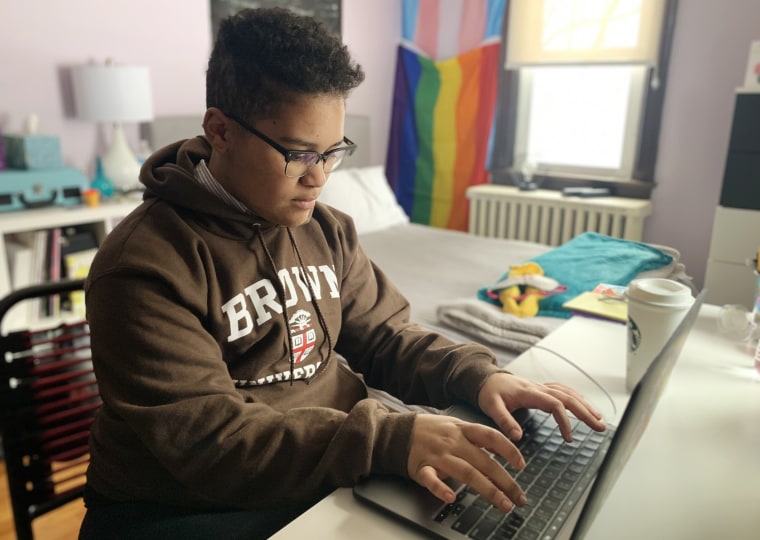
There’s no question that the pandemic has been hard on children , whether or not their schools have reopened. A flood of research in recent months has found alarming spikes in depression and anxiety among children and their parents. Multiple studies have found that students — especially those with disabilities and from low-income families — are learning less than they should.
But a new study from NBC News and Challenge Success , a nonprofit affiliated with the Stanford Graduate School of Education, is one of the first to shed light on the differences between students whose classes have been exclusively online and those who’ve been able to attend in person at least one day per week.
All this week, watch “NBC Nightly News with Lester Holt” and the "TODAY" show for more on “Kids Under Pressure," a series examining the impact of the pandemic on children
The survey last fall of more than 10,000 students in 12 U.S. high schools, including Yonkers, found that students who’d spent time in the classroom reported lower rates of stress and worry than their online peers.
While just over half of all students surveyed said they were more stressed about school in 2020 than they had been previously, the issue was more pronounced among remote students. Eighty-four percent of remote students reported exhaustion, headaches, insomnia or other stress-related ailments, compared to 82 percent of students who were in the classroom on some days and 78 percent of students who were in the classroom full time.
Remote students were also slightly less likely to say they had an adult they could go to with a personal problem and slightly more likely to fret about grades than their peers in the classroom. And the remote students did more homework, reporting an average of 90 additional minutes per week, the study found.
“Remote learning — and I don’t think this is a surprise to anyone — is just more challenging,” said Sarah Miles, the director of research and programs at Challenge Success and one of the leaders of the study. “It’s harder for kids to feel connected. It’s harder for teachers, for the adults in the school, to connect and that’s a foundational element. In order for kids to learn, they need to feel safe and connected. Everything else rests on top of that.”
Challenge Success, an education research and school support organization, surveys most students in dozens of schools a year to help teachers and administrators better meet their needs. The 12 schools surveyed last fall, in Arizona, Texas, New York and the Midwest, are demographically similar to the nation in terms of student family income, though not necessarily in terms of race, Miles said.
The debate around reopening U.S. schools has become increasingly fraught, with parents and political leaders including President Joe Biden loudly calling for schools to reopen and teachers in some parts of the country threatening to walk off the job over safety concerns . On Friday, the Biden administration released guidelines for how to safely reopen schools, advising precautions including masks, social distancing and contact tracing.
Miles said the new research doesn't mean that schools should rush to reopen before putting safety protocols in place. Instead, she said, it shows the importance of making sure teachers and staff members feel comfortable returning to the classroom.
“If they don’t feel safe and supported, kids won’t feel safe and supported,” she said.
But, at the same time, she said, the study underscores the damage online learning is doing.
“We need to prioritize getting to a place where everyone feels comfortable going back to school,” Miles said, “because it’s urgent.”
‘A bit of magic’ in the classroom
All of Jordan Salhoobi’s chemistry students at Yonkers Middle High School are getting the same lessons at the same time.
The ones wearing masks in his classroom hear the same lectures and see the same demonstrations as students watching the livestream at home. When he writes or draws on his computer tablet, students at home see the same images on their screens that students in the classroom see projected on the wall.
But Salhoobi’s students are not getting the same benefits, he said.
“In the room, you get more eye contact,” he said. “On the screen, oftentimes the kid could be sitting in front of a window. You can’t see them, so it’s hard to make sure they’re attentive.”
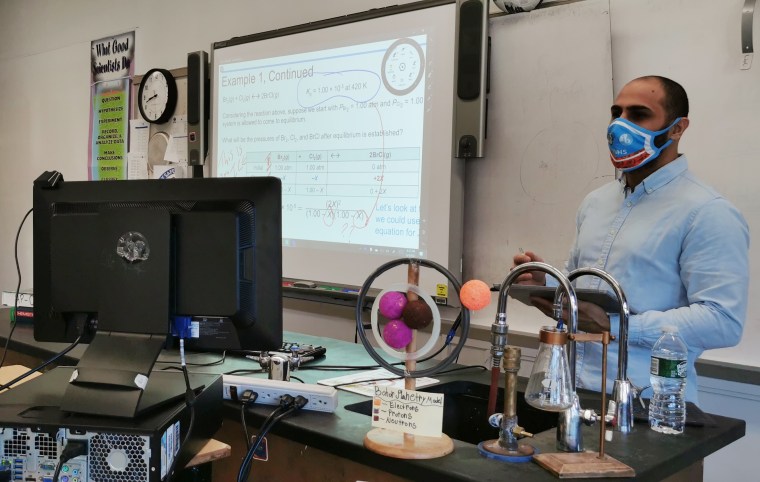
While it’s difficult to compare his students’ performance, Salhoobi said his in-person students sometimes stay after class for extra help that online students rarely ask for. Online students seem more reluctant to raise their hands and they often look tired.
“I think that actually coming to school and getting dressed makes kids feel more like they have a purpose in life,” he said.
When Yonkers started offering a hybrid option in October that allows students to attend in person either Monday and Tuesday or Thursday and Friday, most students chose to remain online. Only about a third of students are currently in the hybrid program, a Yonkers district spokeswoman said, leaving many classrooms with just a handful of students.
Full coverage of the coronavirus outbreak
Yonkers principal Jade Sharp said that she hasn’t seen significant differences in grades or test scores between remote and hybrid students, but that she wasn’t surprised to see survey data showing that her remote students are more stressed.
“I feel sorry for our students in this Covid situation,” she said, noting that many of her 1,100 high school students have responsibilities at home such as caring for younger siblings in addition to their schoolwork. Three-quarters come from families the state considers economically disadvantaged, including many from immigrant families. Some have parents who’ve lost jobs. Some lost loved ones to Covid-19. And many are reeling from the social and political tensions of the past year.
The school goes out of its way to support students, Sharp said, limiting instruction to half days on “wellness Wednesdays,” and hosting after-school clubs focused on mental health.
But none of that offers what even a couple of days in the classroom interacting with teachers and peers can do, said Tara O’Sullivan, who teaches U.S. history at Yonkers.
“There’s a bit of magic that can happen in a classroom,” O’Sullivan said. “There’s nothing like the rapport and energy of kids working with each other, the sort of flow of conversation and bouncing off ideas that’s obviously present in person.”

Headaches and eye strain
Tanya Palmer, 16, a Yonkers junior, has managed to keep up her grades this year — but only because she puts in extra time to make up for what she’s missing in class.
“I don't feel like I'm really learning much,” said Tanya, who chose to stay remote to protect her 75-year-old grandfather, who lives with her family. “There’s a lot of teaching myself things.”
Things have gotten better since the beginning of the school year when technical glitches were more common and teachers were still adjusting. But when she finishes her five hours of online classes each day, she’s often staring down hours of extra research and reading to actually learn the material.
“I get a lot of headaches and eye strain,” she said. “My eyes are so dry, and I get back pain, too.”

The NBC News and Challenge Success study found that online-only students in Yonkers reported an average of 31 minutes more homework on the weekend and 70 more minutes during the week than their classmates in the hybrid program. Though most students were not getting anywhere close to the nine hours of sleep recommended for adolescents, reporting just over six hours, the hybrid students reported sleeping an average of about 10 minutes more per night than their online peers.
“It’s 10 o’clock and I see her on the computer,” said Tanya Gonzalez, Tanya’s mother. “I get close to her, thinking maybe she’s watching a video, but no, she’s doing classwork.”
Download the NBC News app for full coverage and alerts about the coronavirus outbreak
Sean Vargas-Arcia had more energy when he was in school two days a week, and more ways to understand his coursework, he said, recalling how he struggled last semester to visualize the molecular structure of fatty acids known as lipids until he saw a 3-D model in his biology classroom.
“I was like, ‘Oh, that helps,’ because I could actually see it,” he said.
These days, however, Sean is back to being fully online. So few students returned when the school reopened last month after closing for a few weeks because of higher infection rates that he was the only student in some of his classes. He decided there wasn’t much point, so now he wakes up, walks across his room and sits down in front of a computer from 7:45 a.m. to 1 p.m. without a break. A quirk in his schedule put his lunch hour at the end of the day.
With college applications looming, Sean worries his grades in online classes will suffer, costing him his shot at his first-choice, Brown University, next year.
“There’s a lot of anxiety that surrounds thinking about my future,” he said.
He’s also struggling with isolation from his friends. He used the quiet hours over the summer for reflection and, in September, came out to family and friends as transgender. He announced his name change on social media, but most of his classmates haven’t seen him in person since then.
Everything has been more difficult this year for students at Yonkers, an academically selective school that draws a diverse mix of students — half Latino, 20 percent white, 15 percent Asian, 13 percent Black — from the city of the same name just north of New York City. Sports and after-school programs are largely gone, and school events, like the gala Yonkers traditionally throws in the spring to celebrate the many cultures in the school, have been canceled.
For some students, it’s a small price to pay to keep their families safe, said Emma Maher, 17, a junior who chose the online option because her sister has asthma and her grandmother has a compromised immune system.
“The sacrifice is worth it,” she said, “because I value the health of my family and loved ones.”

But educators worry about the long-term impact on a generation of children who are stressed out, struggling to learn and missing their friends.
“You took away so much from these kids,” said Salhoobi, the chemistry teacher. “You took away sports. You took away interactions. It’s kind of like kids are in jail now when they’re 100 percent online.”
Erin Einhorn is a national reporter for NBC News, based in Detroit.
- Search Please fill out this field.
- Manage Your Subscription
- Give a Gift Subscription
- Newsletters
- Sweepstakes
Is Homework a Waste of Students' Time? Study Finds It's the Biggest Cause of Teen Stress
As the debate over the need for homework continues, a new study found that it's the biggest cause of teen stress, leading to sleepless nights and poor academic performance
Julie Mazziotta is the Sports Editor at PEOPLE, covering everything from the NFL to tennis to Simone Biles and Tom Brady. She was previously an Associate Editor for the Health vertical for six years, and prior to joining PEOPLE worked at Health Magazine. When not covering professional athletes, Julie spends her time as a (very) amateur athlete, training for marathons, long bike trips and hikes.
:max_bytes(150000):strip_icc():format(webp)/J.Mazziotta2334-e3daa71fe1a745929e739c08e585253f.jpg)
It’s the bane of every teen’s existence. After sitting through hours at school, they leave only to get started on mountains of homework. And educators are mixed on its effectiveness . Some say the practice reinforces what students learned during the day, while others argue that it put unnecessary stress on kids and parents , who are often stuck nagging or helping.
According to a new study, conducted by the Better Sleep Council , that homework stress is the biggest source of frustration for teens, with 74 percent of those surveyed ranking it the highest, above self-esteem (51 percent) parental expectations (45 percent) and bullying (15 percent).
Homework is taking up a large chunk of their time , too — around 15-plus hours a week, with about one-third of teens reporting that it’s closer to 20-plus hours.
The stress and excessive homework adds up to lost sleep, the BSC says. According to the survey, 57 percent of teenagers said that they don’t get enough sleep, with 67 reporting that they get just five to seven hours a night — a far cry from the recommended eight to ten hours. The BSC says that their research shows that when teens feel more stressed, their sleep suffers. They go to sleep later, wake up earlier and have more trouble falling and staying asleep than less-stressed teens.
“We’re finding that teenagers are experiencing this cycle where they sacrifice their sleep to spend extra time on homework, which gives them more stress — but they don’t get better grades,” said Mary Helen Rogers, the vice president of marketing and communications for the BSC.
RELATED VIDEO: To Help Or Not To Help: Moms Talk About Whether Or Not They Help Their Children With Homework
Another interesting finding from this study: students who go to bed earlier and wake up earlier do better academically than those who stay up late, even if those night owls are spending that time doing homework.
To end this cycle of sleep deprivation and stress, the BSC recommends that students try setting a consistent time to go to sleep each night, regardless of leftover homework. And their other sleep tips are good for anyone, regardless of age — keep the temperature between 65 and 67 degrees, turn off the electronic devices before bed, make sure the mattress is comfy and reduce noise with earplugs or sound machines.
Related Articles
April 18 Dear iSchool juniors: You will be okay
April 2 Mortal Kombat 1: Everything you need to know
April 2 Kids Online Safety Act: Will it help society?
March 7 Movie review: “Don’t Worry Darling”
February 8 What has iSchool been listening this fall and winter?
January 19 Ronaldo vs. Messi – Differences and Similarities
January 19 What iSchoolers are wearing: Updated version!
January 19 The true cost of fast fashion
January 16 What motivates you to work?
January 11 New teachers at the iSchool

The iNews Network

Student stress: How homework really affects education

Sydney Wargo , Reporter January 10, 2019
For centuries, children have been going to school in order to receive an education and learn valuable, basic skills. In the United States, the average student starts going to school when they are 5 years old, and continues on until they are 18. Beyond that, many people seek higher education through colleges, universities, and graduate schools.
Along with school comes homework.The amount of homework a student receives depends on the class, the teacher, and the school.
Many New York City public high schools given 2 to 4 hours of homework a night. These students tend to feel more pressured and anxious about school. However, the iSchool gives much less homework compared to other schools. As a result, the students are much less stressed.
Homework is a main source of stress for students, and it does not improve students’ grades. Schools that give less homework, such as the iSchool, have overall better performing, more mentally stable, less stressed students.
“Too much homework can do more harm than good. Researchers have cited drawbacks, including boredom and burnout toward academic material, less time for family and extracurricular activities, lack of sleep and increased stress,” an article from the American Psychological Association says.
According to a survey sent out to the iSchool community, the majority of 30 respondents reported that they spent 2-4 hours on homework every night. When asked if homework was a major source of stress, 96% of respondents said yes.
Stanford University conducted a study concerning the relationship between homework and stress. Over 4,000 students were asked questions related to how homework affects their stress levels. The results showed that “56 percent of the students considered homework a primary source of stress… Forty-three percent viewed tests as a primary stressor… Less than 1 percent of the students said homework was not a stressor.”
Dela Sluymer, a freshman at Brooklyn Millennium High School, said that she usually has 2 hours of homework per night.
“I’m usually working on essays and projects that I’m not given time to complete in class, and also other worksheets and more small work like that,” Dela says. She admits homework is often stressful for her, and it takes up a lot of her time outside of school.
Typically, students are in school 5 days a week for 6-8 hours a day, not including extracurricular activities. This gives most kids a fairly small amount of time to participate in activities outside of school, such as spending time with friends and family, taking part in hobbies, and more. Unfortunately, homework takes up a lot of this time, further limiting students from their freedom.
At the iSchool, with less homework, students are able to participate in clubs and other extracurricular activities, as well as spend valuable time with loved ones.
Slava Hasuler-Lew, a freshman at the iSchool, explains how less homework has improved her school life. “At this school, I almost never have over an hour of homework a night. Whenever I talk to my friends, they always say they have several hours of homework, and how they’re so stressed out about [it].”
“Having a light homework load has gotten rid of a lot of the negative feelings I used to have surrounding school,” Slava explains. “The less stressed out I am, the better I do in my classes, and homework used to be my main source of stress in middle school.”
Washington Post analyzed a study published in the Journal of Experimental Education. This study surveyed several thousand students on the negative impact of too much homework. The survey revealed that “Many (63%) reported that the amount of work they received oft or always made it challenging to spend time with family and friends, and a similar percent (61%) indicated that they had been forced to drop an activity they enjoyed because of their school workload.”
Noah Mcguane is a freshman at Edward R. Murrow High School. Noah describes his homework load and its affect on him.
“I get a lot of homework on a daily basis. I usually have assigned reading, DeltaMath, worksheets, essays, pretty much any type of assignment you could imagine. I’d say I usually have 2 hours of homework a night, but it varies.”
“Homework can be really stressful and time consuming for me,” Noah says. “It is really important to me that I get good grades and do well, but that mindset sometimes makes me feel even more pressured, making the stress even worse.”
Stress includes a large number of negative side effects that can greatly impact a person’s daily life. Insomnia, exhaustion, acne, headaches, nausea, vulnerability to sickness, mood swings, and short-temperedness are only some of the effects stress can have on people. Extreme stress can have even worse consequences, such as hair loss, depression, and anxiety.
The previously mentioned study conducted by Stanford University shows that many students suffer from similar symptoms when given too much homework. Some students reported that in order to make time for their homework, they deprive themselves of sleep; sleep deprivation on its own comes with many negative side effects.
Having such high stress will inevitably lead to lower performance in school. Stressed students often have trouble focusing in class, making school work harder for them. It is a common misconception that homework leads to better grades; the result is actually the opposite.
When adding up stress, sleep deprivation, and lack of focus, it is impossible for the average adolescent to handle everything and still manage to perform to the best of their ability, leaving many students feeling hopeless.
Compared to the NYC iSchool, students here suffer from less of these problems. Laura Hickson, iSchool freshman, gives her insight on homework: “I have trouble sleeping as it is, and staying up doing homework really doesn’t help with that. Now that I go to the iSchool, I get better sleep, and I feel better when coming to school.”
Huffington Post further alludes this same point in an article discussing the impact large amounts of homework has on students test scores:
“Data shows that in countries where more time is spent on homework, students score lower on a standardized test called the Program for International Student Assessment… The same correlation is also seen when comparing homework time and test performance at schools within countries.”
Homework can be beneficial; it is important to practice in order to fully understand the topics students learn about in school. However, when the amount of homework assigned starts to become excessive, it can negatively impact how a student performs in school.
At the iSchool, the student body’s happiness is one of the main priorities. The lives students have outside of school are taken into consideration when assigning work outside of the classroom. Additionally, many students have Independent Work periods, where they can fully complete homework in school, leaving them stress free for the night.
Rather than making school a stressful environment, school should be a place where students can perform the best they possibly can and truly thrive, focus, and be educated. Education is a privilege, and we shouldn’t mistreat it.
Sydney Wargo is a junior at the NYC iSchool and a reporter for iNews. She enjoys reading and creative writing in and hopes to pursue a career as a journalist.
- Polls Archive

How to become an academic weapon

Why is America so unhealthy?

Traveling’s transformation: Discovering benefits

How does your cat in heat affect others? What can you do to prevent it?

The second avenue subway: A 100 year old aspiration

How do you live your life?

The unspoken half of mental health

The romance and reality of the 90s and early 2000s: Nostalgia, nostalgia everywhere

Luxury vs. drugstore makeup

Now that the college process is over, here’s what some iSchool seniors have learned
The Student News Site of NYC iSchool

Tiger Times

Learning vs. “Getting By”: Students Stressed with Homework Overload
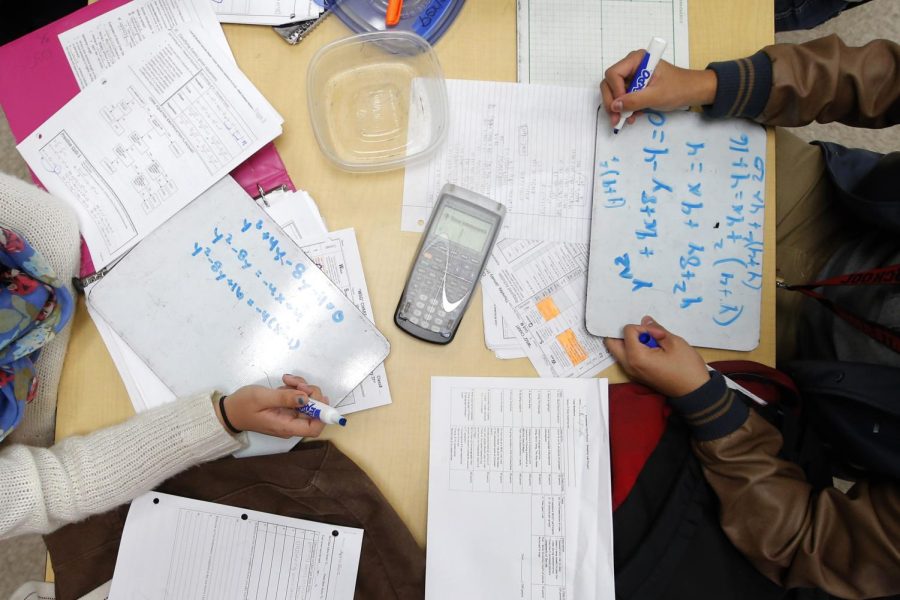
Jae C. Hong
Students solve problems in a pre-calculus class.
Destiny Albrecht , Staff writer September 16, 2022
When finally getting home after a full day of school, a two hour sports practice and five hour work shift, what student is eager to get to their desk, lay out all of their papers and start on the three hours of homework they have ahead?
When it comes to balancing school with a selection of several other activities such as extracurriculars and jobs, it can get stressful. With homework every night and an after school sport or job, there is no time for students to play catch-up.
Many students handle a busy schedule like this every week. A survey sent out to students said 68% work a job during this school year, 57% of them play a sport as well. How do they juggle homework assignments, tests and projects with hours of work and extracurriculars?
“It definitely gets stressful at times,” senior Mackenzie Petry said. “I feel super overwhelmed with practice five days a week. Not to mention, working 25 hours a week during the school year.”
Yet, several chapters of reading or multiple papers to write are presented with tomorrow as a due date. 53% of students said that they have homework in three to five classes every day.
Students feel pressured when it comes to the amount of homework in each of their classes. “I think that homework is important but sometimes it is way too much for someone who has a full course load as well as extracurricular responsibilities,” senior Nathan Hollis said.
Teachers should keep in mind that students are getting multiple assignments from other classes as well, so adding their own to the agenda can make it difficult to stay on track.
In many students’ opinions, homework is essential to the learning experience, but the quantity for each and every night is unnecessary. Finland uses a school system that does not give out homework as often as the United States does, and they have one of the highest ranked education systems in the world, according to the New York Times.
“We are just learning how to make it by and not what we really should be learning,” Petry said.
Even during class, students aren’t paying attention because they are trying to complete either the homework assignment given last night that they didn’t have time to finish or the newest release of work so they don’t have homework that night.
As a result, they’re not learning the material being presented that day, which causes them to fall behind schedule. So really, is the cycle never-ending? More work will have to be done in the long run anyways.
For teachers, this isn’t good either because requirements aren’t met, causing the students’ grades to decrease. Lesson plans could fall apart just like that, causing stress for the teachers as well.
While a lot can be said about the amount of assignments, students also struggle with procrastination, making matters worse. 82% of them fight the urge to wait until a later time to do their work. This causes more stress in the future as well.
Many students suggest tips such as scheduling a study hall during the school year, putting the phone and other distractions away when working on assignments or having a planner to organize homework for each day.
While these are great recommendations, a number of students requested more time to work on homework during class. Some even suggested spacing out the assignments so they have the opportunity to actually understand and do well on it.
“In my opinion, I think teachers should be giving minimal homework in the first place,” Petry said. “The schedule is way overloaded. College kids may get assignments but not near as many and especially ones that are due as fast as our turn around. Ultimately, isn’t college what they’re supposed to be preparing us for?”

Georgia Gaughan , Student Life Editor | April 23, 2024

Julia Towell , A&E Editor | April 19, 2024

Sami McKenney , Opinion Editor | April 19, 2024

Pera Onal , Editor-in-Chief | April 19, 2024

Sydney Andrews , Staff Writer | April 19, 2024
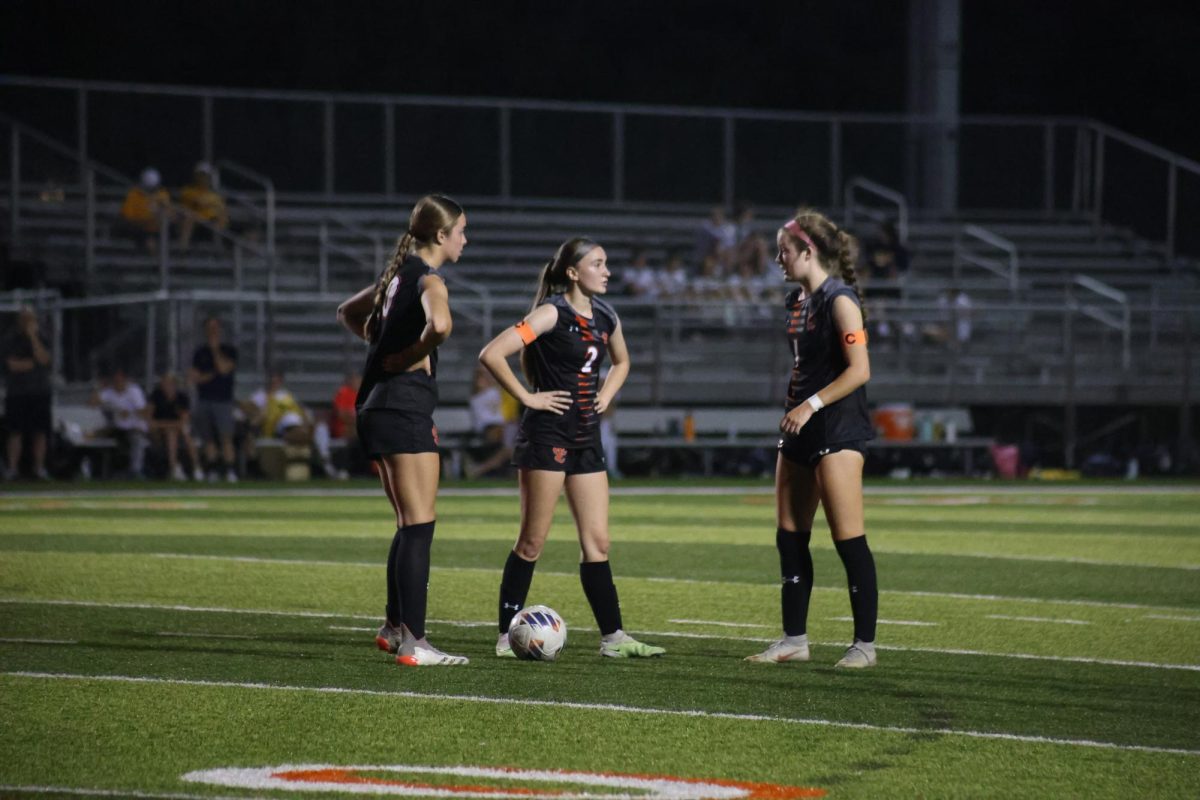
Zach Kennett , Sports Editor | April 19, 2024

Owen Anderson , Staff Writer | April 19, 2024

Georgia Gaughan , Student Life Editor | April 19, 2024

Zach Cohn , Staff Writer | April 19, 2024

Sami McKenney , Opinion Editor | April 15, 2024
View this profile on Instagram EHS Publications (@ edwardsvillepublications ) • Instagram photos and videos

Student Life
Ethics Bowl Continues Best Season in History
The Final ‘Push’ in Studying for AP Exams

Family, Found: Black Student Union Begins Forging Legacy of Togetherness

Care Closet Gives Numerous Helping Hands

Eclipse Expedition: Mapping Out Your Solar Spectacle Adventure

Orchard Town Center Announces Popular New Tenants

Science Olympiad Team Places at Regionals, Shocks Members
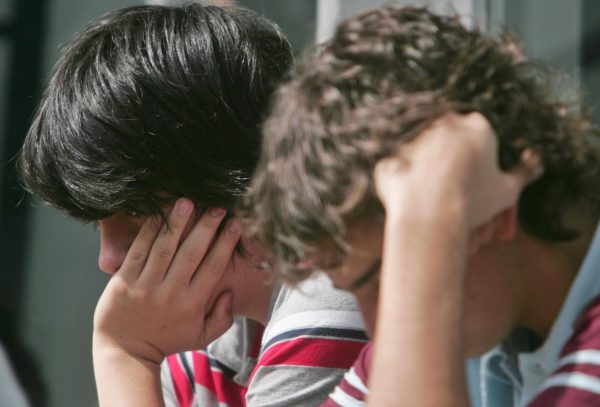
The Struggles with Junior Year

Freshman Phenom Sophie Shapiro: Triple the Sports, Triple the Triumph

EHS Journalism Students Dominate SISPA Awards

The student news site of Edwardsville High School

- Spring Member Drive
- Join our nonprofit and nonpartisan newsroom today to build a better California for tomorrow.
- Newsletters
- Environment
- 2024 Voter Guide
- Digital Democracy
- Daily Newsletter
- Data & Trackers
- California Divide
- CalMatters for Learning
- College Journalism Network
- What’s Working
- Youth Journalism
- Manage donation
- News and Awards
- Sponsorship
- Inside the Newsroom
- CalMatters en Español
Will less homework stress make California students happier?

Share this:
- Click to share on X (Opens in new window)
- Click to share on Facebook (Opens in new window)
- Click to share on WhatsApp (Opens in new window)

A bill from a member of the Legislature’s happiness committee would require schools to come up with homework policies that consider the mental and physical strain on students.
Lea esta historia en Español
Update: The Assembly education committee on April 24 approved an amended version of the bill that softens some requirements and gives districts until the 2027-28 school year. Some bills before California’s Legislature don’t come from passionate policy advocates, or from powerful interest groups.
Sometimes, the inspiration comes from a family car ride.
While campaigning two years ago, Assemblymember Pilar Schiavo ’s daughter, then nine, asked from the backseat what her mother could do if she won.
Schiavo answered that she’d be able to make laws. Then, her daughter Sofia asked her if she could make a law banning homework.
“It was a kind of a joke,” the Santa Clarita Valley Democrat said in an interview, “though I’m sure she’d be happy if homework were banned.”
Still, the conversation got Schiavo thinking, she said. And while Assembly Bill 2999 — which faces its first big test on Wednesday — is far from a ban on homework, it would require school districts, county offices of education and charter schools to develop guidelines for K-12 students and would urge schools to be more intentional about “good,” or meaningful homework.
Among other things, the guidelines should consider students’ physical health, how long assignments take and how effective they are. But the bill’s main concern is mental health and when homework adds stress to students’ daily lives.
Homework’s impact on happiness is partly why Schiavo brought up the proposal last month during the first meeting of the Legislature’s select committee on happiness , led by former Assembly Speaker Anthony Rendon .
“This feeling of loneliness and disconnection — I know when my kid is not feeling connected,” Schiavo, a member of the happiness committee, told CalMatters. “It’s when she’s alone in her room (doing homework), not playing with her cousin, not having dinner with her family.”
The bill analysis cites a survey of 15,000 California high schoolers from Challenge Success, a nonprofit affiliated with the Stanford Graduate School of Education. It found that 45% said homework was a major source of stress and that 52% considered most assignments to be busywork.
The organization also reported in 2020 that students with higher workloads reported “symptoms of exhaustion and lower rates of sleep,” but that spending more time on homework did not necessarily lead to higher test scores.
Homework’s potential to also widen inequities is why Casey Cuny supports the measure. An English and mythology teacher at Valencia High School and 2024’s California Teacher of the Year , Cuny says language barriers, unreliable home internet, family responsibilities or other outside factors may contribute to a student falling behind on homework.
“I never want a kid’s grade to be low because they have divorced parents and their book was at their dad’s house when they were spending the weekend at mom’s house,” said Cuny, who plans to attend a press conference Wednesday to promote the bill.
In addition, as technology makes it easier for students to cheat — using artificial technology or chat threads to lift answers, for example — Schiavo says that the educators she has spoken to indicate they’re moving towards more in-class assignments.
Cuny agrees that an emphasis on classwork does help to rein in cheating and allows him to give students immediate feedback. “I feel that I should teach them what I need to teach them when I’m with them in the room,” he said.

The bill says the local homework policies should have input from teachers, parents, school counselors, social workers and students; be distributed at the beginning of every school year; and be reevaluated every five years.
The Assembly Committee on Education is expected to hear the bill Wednesday. Schiavo says she has received bipartisan support and so far, no official opposition or support is listed in the bill analysis.
The measure’s provision for parental input may lead to disagreements given the recent culture war disputes between Democratic officials and parental rights groups backed by some Republican lawmakers. Because homework is such a big issue, “I’m sure there will be lively (school) board meetings,” Schiavo said.
Nevertheless, she says she hopes the proposal will overhaul the discussion around homework and mental health. The bill is especially pertinent now that the state is also poised to cut spending on mental health services for children with the passage of Proposition 1 .
Schiavo said the mother of a student with attention deficit/hyperactivity disorder told her that the child’s struggle to finish homework has raised issues inside the house, as well as with the school’s principal and teachers.
“And I’m just like, it’s sixth grade!” Schaivo said. “What’s going on?”

Lawmakers want to help California be happy
We want to hear from you
Want to submit a guest commentary or reaction to an article we wrote? You can find our submission guidelines here . Please contact CalMatters with any commentary questions: [email protected]
Lynn La Newsletter Writer
Lynn La is the WhatMatters newsletter writer. Prior to joining CalMatters, she developed thought leadership at an edtech company and was a senior editor at CNET. She also covered public health at The Sacramento... More by Lynn La
We've recently sent you an authentication link. Please, check your inbox!
Sign in with a password below, or sign in using your email .
Get a code sent to your email to sign in, or sign in using a password .
Enter the code you received via email to sign in, or sign in using a password .
Subscribe to our newsletters:
- WeeklyMatters Catch up on the top stories in California with a summary of our reporting and commentary from the past week.
- Weekly Walters Get a digest of new insights from veteran journalist Dan Walters, who holds powerful people in California accountable.
- WhatMatters Start your day with a comprehensive rundown of the most important stories in California politics and policy.
- Inequality Insights Your weekly must-read to stay on top of inequality, one of California’s most pressing issues.
Sign in with your email
Lost your password?
Try a different email
Send another code
Sign in with a password

Will less homework stress make California students happier?

Some bills before California’s Legislature don’t come from passionate policy advocates, or from powerful interest groups.
Sometimes, the inspiration comes from a family car ride.
While campaigning two years ago, Assemblymember Pilar Schiavo ’s daughter, then nine, asked from the backseat what her mother could do if she won.
Schiavo answered that she’d be able to make laws. Then, her daughter Sofia asked her if she could make a law banning homework.
“It was a kind of a joke,” the Santa Clarita Valley Democrat said in an interview, “though I’m sure she’d be happy if homework were banned.”
Still, the conversation got Schiavo thinking, she said. And while Assembly Bill 2999 — which faces its first big test on Wednesday — is far from a ban on homework, it would require school districts, county offices of education and charter schools to develop guidelines for K-12 students and would urge schools to be more intentional about “good,” or meaningful homework.
Among other things, the guidelines should consider students’ physical health, how long assignments take and how effective they are. But the bill’s main concern is mental health and when homework adds stress to students’ daily lives.
Homework’s impact on happiness is partly why Schiavo brought up the proposal last month during the first meeting of the Legislature’s select committee on happiness , led by former Assembly Speaker Anthony Rendon .
“This feeling of loneliness and disconnection — I know when my kid is not feeling connected,” Schiavo, a member of the happiness committee, told CalMatters. “It’s when she’s alone in her room (doing homework), not playing with her cousin, not having dinner with her family.”
The bill analysis cites a survey of 15,000 California high schoolers from Challenge Success, a nonprofit affiliated with the Stanford Graduate School of Education. It found that 45% said homework was a major source of stress and that 52% considered most assignments to be busywork.
The organization also reported in 2020 that students with higher workloads reported “symptoms of exhaustion and lower rates of sleep,” but that spending more time on homework did not necessarily lead to higher test scores.
Homework’s potential to also widen inequities is why Casey Cuny supports the measure. An English and mythology teacher at Valencia High School and 2024’s California Teacher of the Year , Cuny says language barriers, unreliable home internet, family responsibilities or other outside factors may contribute to a student falling behind on homework.
“I never want a kid’s grade to be low because they have divorced parents and their book was at their dad’s house when they were spending the weekend at mom’s house,” said Cuny, who plans to attend a press conference Wednesday to promote the bill.
In addition, as technology makes it easier for students to cheat — using artificial technology or chat threads to lift answers, for example — Schiavo says that the educators she has spoken to indicate they’re moving towards more in-class assignments.
Cuny agrees that an emphasis on classwork does help to rein in cheating and allows him to give students immediate feedback. “I feel that I should teach them what I need to teach them when I’m with them in the room,” he said.

The bill says the local homework policies should have input from teachers, parents, school counselors, social workers and students; be distributed at the beginning of every school year; and be reevaluated every five years.
The Assembly Committee on Education is expected to hear the bill Wednesday. Schiavo says she has received bipartisan support and so far, no official opposition or support is listed in the bill analysis.
But she does acknowledge that, if passed, the measure’s provision for parental input may lead to disagreements given the recent culture war disputes between Democratic officials and parental rights groups backed by some Republican lawmakers. “I’m sure there will be lively (school) board meetings,” Schiavo said.
Nevertheless, she says she hopes the proposal will overhaul the discussion around homework and mental health. The bill is especially pertinent now that the state is also poised to cut spending on mental health services for children with the passage of Proposition 1 .
Schiavo said the mother of a student with attention deficit/hyperactivity disorder told her that the child’s struggle to finish homework has raised issues inside the house, as well as with the school’s principal and teachers.
“And I’m just like, it’s sixth grade!” Schaivo said. “What’s going on?”
This article was originally published by CalMatters .

‘Too many of us are stressed and losing sleep’: Students explain why school needs to change
Our panel of pupils want more creativity, less emphasis on homework and greater recognition of learning outside the classroom.
Erlandino Doha, Conor Dunne Atkins, Sofia Moran and Philippa McIntosh
It was the day everything changed: March 12th, 2020. Schools were shut and catapulted into an experiment in remote learning on a huge scale.
In many ways, the education system showed its resilience amid the chaos – but in other ways, the pandemic was a jolting reminder of an underfunded education system rooted in a 20th-century model of learning.
What we have learned since, combined with the rise of AI and its potential to reshape education, provides an ideal moment to debate what school is for and where it should go next.
As the Government’s plans to hold a citizens’ assembly on the future of education hang in the balance due, partly, to the change of taoiseach , The Irish Times is leading a debate about how to future-proof teaching and learning.
Court appearances due over Newtownmountkennedy protests
:quality(70)/cloudfront-eu-central-1.images.arcpublishing.com/irishtimes/MY5ZLS3I65FWHG7MHSPX4QLDL4.JPG)
New laws needed to deal with asylum seekers arriving into State from North, says Taoiseach
:quality(70):focal(3907x2759:3917x2769)/cloudfront-eu-central-1.images.arcpublishing.com/irishtimes/HX6BIDUXMVDV5JIYQGVHN7JQU4.jpg)
Younger teachers in Catholic schools less likely to believe in God or attend religious services
:quality(70)/cloudfront-eu-central-1.images.arcpublishing.com/irishtimes/OJRDUZ4KONGNGJ3HPGZWY35XRI.jpg)
Last month we canvassed business leaders, educators, cultural figures and scientists for their views . Now, it’s students’ turn to have their say.
Our panel includes pupils of different ages, backgrounds and school types. It includes: Sofia Moran (8), a second-class student in Holly Park, Dublin; Conor Dunne Atkins (14), a second-year student at Clogher Road Community College, Dublin 8; Síofra (15), a third-year student at a school in Salthill, Co Galway; Philippa McIntosh (16), a transition-year student at Bandon Grammar School, Co Cork; Erlandino Doda (17), a sixth-year bursary recipient student at Belvedere College in Dublin 1; and Hazel (17) who attends iScoil, an online-learning service.
Philippa McIntosh. Photograph: Andy Gibson
Restrictive curriculum: ‘We’re not given a chance to really think for ourselves’
Philippa McIntosh (16) says one of the biggest negatives is that the curriculum restricts how students learn.
“Even art, which should be free and creative, is restricted by the curriculum,” she says. “I understand the reason behind homework, but the sheer volume of it can be overwhelming.”
Conor Dunne Atkins (14) also feels that while teachers at his school “really do listen to us”, they still have to deliver the curriculum in a particular way.
“We are all taught the same and not given a chance to really think for ourselves,” he says. “We need to be given more opportunities to question everything.”
These issues also affect primary level. Sofia Moran (8) says when she started school it was lots of fun, but now the focus is on more traditional lessons.
“Maths is one of my favourite subjects, but it has become more about learning the information than about enjoying it. But I think that is just what the teachers have to teach, because that is what they are told to do.”
Conor Dunne Atkins (14). Photograph: Nick Bradshaw
Homework: ‘It’s excessive’
Almost all our panel say they understand the need for homework – they just feel there is too much emphasis on it.
“The sheer volume of it can be overwhelming,” says Philippa McIntosh. As a dyslexic student, she would like if there were more leeway and understanding. “Yes, there’s allowances made in the exams, but we still have to spend much longer on our homework, and if it’s not completed, it will be held against us.”
Similarly, Hazel feels homework is “far too long” and adds to the anxiety of second level. “Homework adds to the pressure, and you don’t get any time to yourself at all,” she says.
By the time Síofra (15) gets home from school, she feels so much time is spent on homework that there’s little space or energy for anything else.
“Already, attention is turning to our [transition year] and Leaving Cert subjects, with a focus on which subjects are more likely to get us a H1. It shouldn’t have to be this way,” she says.
The points race: ‘It shouldn’t have to be this way’
As a sixth-year student, Erlandino Doda (17) know all about the points race.
“One of the big problems is how much is built around the CAO. There should be more options, more critical thinking and more input of student voices. Yes, there is an internal student council, and the ISSU is there, but I am not sure whether the Government really listens to the student voice,” he says.
Philippa (16) feels more should be done to make the curriculum more accessible and less stressful. “There are so many young people who are stressed and losing sleep: this is not how we should be spending our childhood,” she says.
Erlandino says policymakers should look at the international baccalaureate as a model. “In maths, for instance, students do a project on any area outside the curriculum. And they might look at continuous assessments, projects and alternative routes to college. As a bursary student, I am grateful for the opportunity, but you shouldn’t have to access a fee-paying school to have more chances of a better life – it is unfair,” he says.
Sofia Moran (8). Photograph: Nick Bradshaw
Learning outside school: ‘Rat race leaves no time for this’
While Conor Dunne Atkins (14) says school is necessary, he feels it is not the only route to success. “I have an online business selling clothes ( unpluggedclothes.com ) that I started when I was 12. We should be encouraged to make plans that don’t just revolve around college,” he says.
Erlandino would also like to see more acknowledgment of what students do outside school. “For instance, I organise events in my own free time, but the education system gives no credit, and the intensity of the rat race leaves no time for things like this,” he says.
Philippa also feels that the intense nature of the exams means many students don’t have time for extracurricular activities.
“I used to do swimming but had to stop because there wasn’t time. I would like to see whether we could be given some credit for involvement in volunteering, sport or other activities,” she says.
Síofra (15) feels subjects should be more focused on skills you need in life, such as business and home economics. “I would also like to see more school trips and exchanges, that are not just tied to whether your school does them,” she says.
Erlandino Doha
Better use of tech: ‘We barely even notice that we’re learning’
Hazel (17), who attends iScoil, says she has seen first hand how education doesn’t need to be delivered in a school setting.
“You can achieve an education without having to physically go somewhere: with technology becoming more relevant in today’s society, you can work from home online,” she says.
“Since I have been attending iScoil, I have rarely been sick or had to go to the doctors as much, as working from home is an environment that I am comfortable in. It has completely changed my life for the better and I am so grateful.”
Sofia (8) has seen how apps can make learning subjects such as learning much more enjoyable.
“There are lots of fun things they could do with apps or reading games, so we barely even notice that we are learning,” she says. “We could also do charades in Irish, for example. There is too much sitting still for six hours in school: we are children, we should be moving around more.”
- Follow The Irish Times education section on Facebook and X and stay up to date
IN THIS SECTION
Irish universities risk undermining their autonomy through self-inflicted wounds, ‘i’m alone pretty much all the time. the older i become, the less hopeful i am this will change’, former taoiseach leo varadkar raises concerns about racism in late late show interview, palestinians sleeping rough in dublin face intimidation as 1,758 asylum seekers now homeless, kidnapped: the extraordinary story of the six-year-old abducted by the catholic church, joe duffy’s snap judgment on simon harris’s stardust apology somehow captures the wider mood, latest stories, poem of the week: apologies.
:quality(70)/cloudfront-eu-central-1.images.arcpublishing.com/irishtimes/RRLGHH33S55VWKRGGCBLWCHUTI.jpg)
Martyn Turner
:quality(70)/cloudfront-eu-central-1.images.arcpublishing.com/irishtimes/3CUFH3HWGBFD5FLSXSRGQGTDFY.jpg)
If this lichen is growing in your area, it means the air you breathe is clean
:quality(70)/cloudfront-eu-central-1.images.arcpublishing.com/irishtimes/B4CHOJYEHBC73EQYJBEBGDSMNQ.jpg)
Arrival of first overseas bank since Celtic Tiger a ‘win’ for consumers
:quality(70)/cloudfront-eu-central-1.images.arcpublishing.com/irishtimes/QXZJI4MMLZA6DAMQNNA2SBVXTY.jpg)
Roberto Cavalli obituary: Designer known for his hectic, blingy, classless aesthetic
:quality(70)/cloudfront-eu-central-1.images.arcpublishing.com/irishtimes/HMN6XYILLSBVFSRAZOXPTKLB6U.jpg)
In a Word...Verisimilitude
:quality(70)/cloudfront-eu-central-1.images.arcpublishing.com/irishtimes/CREUCOW3JNDDVEZBEON42JJP5E.jpg)
Trina Robbins obituary: the first female illustrator to draw Wonder Woman
:quality(70)/cloudfront-eu-central-1.images.arcpublishing.com/irishtimes/PDEIER7AYFBJZHEQUO62QP5RKQ.jpg)
- Terms & Conditions
- Privacy Policy
- Cookie Information
- Cookie Settings
- Community Standards

IMAGES
VIDEO
COMMENTS
36.5% of U.S. college students pointed to stress as the biggest reason why their academic performance suffered negatively for the past 12 months. In addition, 29.5 % listed anxiety as a factor. For American middle schoolers, 61% of teens admitted feeling a lot of pressure to get good grades.
7. 74% of Teens cite Homework as a Source of Stress. A study by the Better Sleep Council found that homework is a source of stress for 74% of students. Only school grades, at 75%, rated higher in the study. That figure rises for girls, with 80% of girls citing homework as a source of stress.
• Greater stress: 56 percent of the students considered homework a primary source of stress, according to the survey data. Forty-three percent viewed tests as a primary stressor, while 33 percent put the pressure to get good grades in that category. Less than 1 percent of the students said homework was not a stressor.
The answer may not be to eliminate homework completely, but to be more mindful of the type of work students go home with, suggests Kang, who was a high-school teacher for 10 years.
March 10, 2014 Stanford research shows pitfalls of homework. A Stanford researcher found that students in high-achieving communities who spend too much time on homework experience more stress ...
Homework was a leading cause of stress, with 24 percent of parents saying it's an issue. Teenagers say they're suffering, too. A survey by the American Psychological Association found that nearly ...
Studies of typical homework loads vary: In one, a Stanford researcher found that more than two hours of homework a night may be counterproductive.The research, conducted among students from 10 high-performing high schools in upper-middle-class California communities, found that too much homework resulted in stress, physical health problems and a general lack of balance.
October 1, 2003. Two new reports debunk the notion that U.S. schoolchildren suffer from a growing homework load, with little time to play and just be kids. The great majority of students at all ...
The answer may not be to eliminate homework completely but to be more mindful of the type of work students take home, suggests Kang, who was a high school teacher for 10 years.
Key points. Generally, homework should include about 10 minutes per night per grade level. The value of homework is debated, with questions about the right amount and potential for inequity ...
Effects of homework stress at home. Both parents and students tend to get stressed out at the beginning of a new school year due to the impending arrival of homework.. Nightly battles centered on finishing assignments are a household routine in houses with students. Research has found that too much homework can negatively affect children. In creating a lack of balance between play time and ...
Use a calm voice. When kids feel anxious about homework, they might get angry, yell, or cry. Avoid matching their tone of voice. Take a deep breath and keep your voice steady and calm. Let them know you're there for them. Sometimes kids just don't want to do homework. They complain, procrastinate, or rush through the work so they can do ...
Engaging teens in constructive conversations to figure out how they fell behind can be an important lesson unto itself. "Having a 16-year-old who understands, 'When I'm stressed, this is how ...
1. Potential Psychological Effects of Homework-Induced Stress: • Anxiety: The pressure to perform academically and meet homework expectations can lead to heightened levels of anxiety in students. Constant worry about completing assignments on time and achieving high grades can be overwhelming. • Sleep Disturbances: Homework-related stress ...
Want more writing prompts? You can find all of our questions in our Student Opinion column.Teachers, check out this guide to learn how you can incorporate them into your classroom. Students 13 and ...
Students who report high levels of stress are also more likely to experience academic problems such as poor grades and dropping out. (American College Health Association) On average, high school students spend 17.5 hours per week on homework.
Study shows remote students face more stress, exhaustion than those in classroom. 01:50. The survey last fall of more than 10,000 students in 12 U.S. high schools, including Yonkers, found that ...
Keywords: homework, stress, mental health The outcomes of adolescent mental health is a threat to students' health and wellbeing, more so than it ever has been in the modern era. As of 2019, the CDC reported a nearly 40. percent increase in feelings of sadness or hopelessness over the last ten years, and similar.
According to a new study, conducted by the Better Sleep Council, that homework stress is the biggest source of frustration for teens, with 74 percent of those surveyed ranking it the highest ...
According to a survey sent out to the iSchool community, the majority of 30 respondents reported that they spent 2-4 hours on homework every night. When asked if homework was a major source of stress, 96% of respondents said yes. Stanford University conducted a study concerning the relationship between homework and stress.
With homework every night and an after school sport or job, there is no time for students to play catch-up. Many students handle a busy schedule like this every week. A survey sent out to students said 68% work a job during this school year, 57% of them play a sport as well.
The bill analysis cites a survey of 15,000 California high schoolers from Challenge Success, a nonprofit affiliated with the Stanford Graduate School of Education. It found that 45% said homework was a major source of stress and that 52% considered most assignments to be busywork. The organization also reported in 2020 that students with higher ...
The bill analysis cites a survey of 15,000 California high schoolers from Challenge Success, a nonprofit affiliated with the Stanford Graduate School of Education. It found that 45% said homework ...
'Too many of us are stressed and losing sleep': Students explain why school needs to change Our panel of pupils want more creativity, less emphasis on homework and greater recognition of ...
• Greater stress: 56 percent of the students considered homework a primary source of stress, according to the survey data. Forty-three percent viewed tests as a primary stressor, while 33 ...
Despite working a full-time job in human relations and caring for her 6-year-old son Chase and 3-year-old daughter Millie, Anne Helms often feels isolated and lonely.
The No. 1 reason students have thought about leaving school is due to financial challenges (30 percent), followed by motivation or life changes (24 percent) and mental health challenges (18 percent). This is on-par with national data from Gallup and the Lumina Foundation, which identified emotional stress (54 percent), mental health reasons (43 ...